|
|
|
|
Community Board 6
|
Police Precinct 76
|
Council Member Sara Gonzalez
|
|
Assembly Member Felix Ortiz
|
U.S. Rep. Nydia Velazquez
|
U.S. Sen. Charles Schumer
|
U.S. Sen Hillary Rodham Clinton
|
Borough President Marty Markowitz
|
Comptroller William C. Thompson Jr.
|
Public Advocate Betsy Gotbaum
|
Mayor Michael Bloomberg
|
Governor George Pataki
|
|
|
Added Value, Red Hook Farmers Market
|
Brooklyn Waterfront Artists Coalition
|
Falconworks
|
Hook Productions
|
Kentler International Drawing Space |
PortSide NewYork
|
Red Hook Health Initiative
|
Red Hook Rise
|
Waterfront Matters
|
The Waterfront Museum Barge
|
|
|
|
423 Smith
|
|
A Brooklyn Life
|
|
Amy Langfield's New York Notebook
|
Big Cities Big Boxes
|
Brooklyn Ramblings
|
Brownstoner
|
Callalillie
|
Curbed
|
Daily Heights
|
Daily Slope
|
danconnortown
|
Dope on the Slope
|
Gowanus Lounge
|
Only the Blog Knows Brooklyn
|
The Real Estate
|
sea level :: new york
|
|
|
|
|
BBC News
|
The Christian Science Monitor
|
Los Angeles Times
|
NPR
|
The New York Observer
|
|
The New York Times
|
Salon
|
The Washington Post
|
|
| B61 Productions is an independent news site dedicated to covering Red Hook, Brooklyn. Email news tips to Editor Steve McFarland. |
|

|
|
Friends and family gathered together to bid farewell to Barry Jetter on the evening of Friday, June 17. Jetter, who died in his sleep the previous Saturday at age 54, had become a fixture on Columbia St. as the quirky, bearded owner of a furniture store.
Nicknamed the "Chrome King" since his days vending at the 26th St. flea market, the off-beat Jetter was known to many for his love of the Grateful Dead and the rare 1940s and '50s furniture he sold.
"He had a different kind of humor," said his mother Lorraine, who was clearly touched by the candlelight vigil in honor of her son. "He would say something and there was always an underlying meaning to it."
The sign that hung above the crowd of 50 mourners served as an example of Jetter's unique sense of humor. His parents hoped Barry would eventually take over their business "General Nightwear." But Barry resisted their professional grooming and whole-heartedly pursued his passion for furniture. With a nod towards the family business he named his store "General Nitemare."
Jetter received a B.S. in business from Babson College in Babson Park, Massachusetts. He was survived by his father Seymour, mother Lorraine, sister Susan Krongold and brother-in-law Steven Krongold. He was preceded in death by his sister Joyce.
"He was a definite character," Susan said of her brother. And as evidenced by the outpouring of emotion Friday night, Barry Jetter is a character that will live on in Red Hook lore.
|
|

|
|
Barry O'Meara and other members of the Mediocre Carnival put the finishing touches on their Whalephant last Friday evening. The float, sponsored by Bait and Tackle, served as the center of Red Hook's contingent at Saturday's Mermaid Parade in Coney Island. With a contortionist unable to touch his toes, a bearded lady who was neither bearded nor a lady and a manically depressed ringleader the carnival made a big splash at this year's parade in Coney Island.
|
|

|
|
The Statue lit up in bursts of red, white and blue from Valentino Pier. The Brooklyn Bridge and Manhattan Skyline framed the midtown display as it accented the tops of container port cranes. Clumps of people gathered on rooftops and otherwise dark industrial shadows to view simultaneous displays out of the far corners of each eye.
Even the ensuing traffic jam at Van Brunt St.'s only stop light couldn't dampen the spirit as droves of people flooded Red Hook's dead-end streets to catch a glimpse of New York City's July 4th pyrotechnics. (Photo by Jessica Dheere)
|
|

|
|
The former Todd Shipyard property on Beard St. is now owned by IKEA. The 22-acres were purchased for $31.25 million from U.S. Dredging Corporation on Wednesday, June 2. IKEA released a statement from spokesman Joseph Roth on June 4.
"Now that we have closed on the property, we will begin developing more
defined timetables for site cleanup and asbestos remediation, demolition
and construction, as well as the implementation of the unique job
training and local hiring programs being created for the Red Hook
community."
Last week U.S. Dredging was scheduled to go before the Environmental Control Board for alleged mishandling of asbestos from the partial demolition of Building #3 in January. The Department of Environmental Protection issued 18 violations. The hearing was rescheduled for July 8. U.S. Dredging's lawyer will argue that DEPs regulations pertain only to "friable" asbestos (easily crumbled or airborne), and that the asbestos in question was non-friable. A DEP spokesperson dismisses the argument and has vowed that any demolition permit request made by IKEA will be subject to the "utmost scrutiny" from his agency.
Roth's statement concludes, "We look forward to sharing more detailed plans and timetables once they are in place."
|
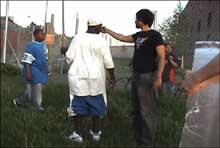
|
|
Teens at the Red Hook Recreation Center are producing a crime prevention public service announcement. They're members of Hook Productions, an after-school program at the center that teaches video and audio production techniques. Last week the group, led by instructors Oja Vincent and Kym Clark, hosted a screening of "Every Mother's Son" and "NYPD Blues," two films that deal with police brutality in Brooklyn.
| |
|
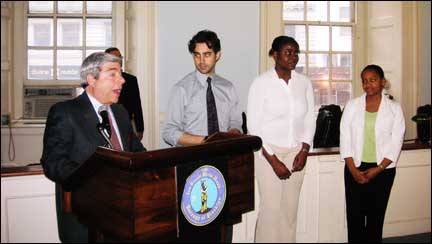
|
|
New Horizons Middle School teacher Tom Mullane (second from left) is this year's Robert Acito Award-winner and Adenike Akingbade (third from left) and Leigh-Ann Martinez (far right) are winners of the Youth Acknowledgment Award. Marty Markowitz presented the honors at the last CB6 general board meeting. The Acito award is given to an adult who exhibits a commitment to becoming a positive force in the lives of young people. Mullane, a Red Hook resident, started a rock climbing club for students at the school.
|

|
|
The New York Daily News reports that developer Bruce Batkin has received court-approval to convert 160 Imlay St. into high-end condos. Lawyers representing Red Hook-Gowanus Chamber of Commerce vow to continue an aggressive fight against the development.
|
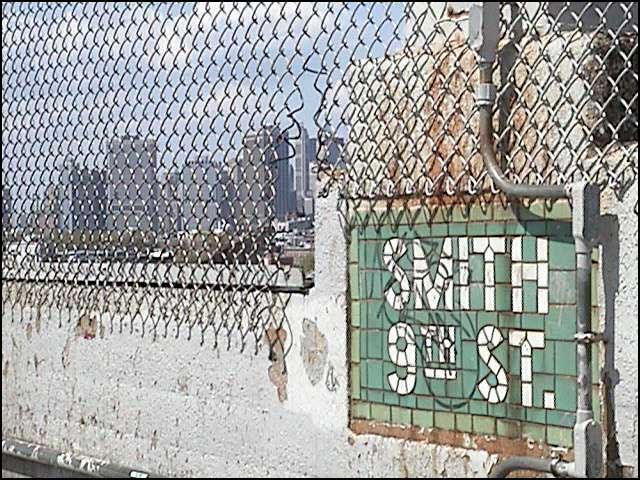
|
|
Previously in line for a $22 million reconstruction effort, Smith and 9th Street has fallen victim to cuts by the MTA. "Of the 12 stations where renovations were slated to be cut, seven of them are in Brooklyn. And the Smith and 9th St. is probably the most deplorable," said CB6 Chairperson Jerry Armer at Wednesday night's general board meeting.
The board voted to state its objection to the city and the MTA as "strongly as possible." Their position is supported by Brooklyn Borough President Marty Markowitz who was in attendance.
In related news, the MTA and NYPD have lifted a ban on photography in and around subways.
|

|
|
|
|
|
|
|
EDC plans to fix "series of historical accidents"
|

|
(Satellite image from Google Earth)
Originally posted Dec. 5, 2005
|
In his preface to last Monday night's Community Board 6 subcommittee meeting, Chair Al Nembhard advised the audience to listen before erupting "in whatever amount of approval or disapproval that you would like."
As it turned out, Nembhard's ground rule wasn't needed as the New York Economic Development Corporation's Kate Ascher presented a plan for piers 7 through 12 that evoked no eruptions from the 80 residents in attendance. The Economic/Waterfront Development Subcommittee went on-the-record supporting EDC's broad outline.
The plan was short on details beyond cruise ships calling at piers 11 and 12. Beginning with the Queen Mary visiting the Atlantic Basin on April 15, 2006, Carnival and Norwegian cruise lines will bring 35 to 40 calls per year. Pier 10 will become a third berth in five years, according to the EDC's blueprint for the 1.1 mile stretch of waterfront.
The remaining piers will be filled with a mix of tenants who adhere to a principle of "sustaining and enhancing Red Hook's maritime identity," Ascher said. "That will be the foundation of anything we build on the piers going forward."
EDC envisions a mix of businesses that either supply maritime support services or depend upon water-borne transport. The current tenant, American Stevedoring Inc., is Brooklyn's last remaining shipping container port. That lease expires in 2007. Likely to move to Red Hook's piers are businesses about to be evicted from the future Brooklyn Bridge Park at piers 1 through 5. The Brooklyn Brewery is also mentioned as a likely tenant on pier 7.
The EDC's presentation cited Granville Island, Vancouver as an example of this vision for Red Hook. The small peninsula was used for heavy industrial use starting in 1917, including ship building during World War II. But it fell into disrepair before business and governmental interests began to redevelop the town in the 1970s as a multi-use area for light industry, commerce and entertainment. Granville Island's Business and Community Association's website describes the town's identity this way, "Embracing the surrounding metropolitan bustle... its gritty, industrial past is proudly displayed in today's people-friendly, artistic, and energetic incarnation."
Following the Granville Island model, the EDC proposes to integrate cultural venues, light industry and public waterfront access in Red Hook.
Nembhard stressed that neither CB6 nor the City envision housing on Red Hook's waterfront. "We don't think that's an appropriate maritime use," he said without mentioning the contested conversion of a 225,000-square-foot warehouse at 160 Imlay St.
Bordering the future cruise ship terminal, the on-again-off-again residential project has thus far been successfully halted in court by the Red Hook/Gowanus Chamber of Commerce. Developer Bruce Batkin has vowed to press forward with his plans to build luxury condominiums on the site overlooking New York Harbor and eventually turning the twin structure next door into a hotel. The suit contends that the project would impede industrial uses for the site and drive up rents in a neighborhood already bracing for rapid gentrification.
Throughout the year-long legal proceedings, the battle lines have been viewed by many as ASI's heavy-industrial use of the waterfront versus the future tenants of luxury condominiums. However, EDC's plan doesn't explicitly endorse the inclusion of either party.
Another entity that may have trouble fitting into the blueprint is the garbage transfer site on Ferris St. Residents have long complained about the smells emitted from the operation. Ascher agreed with residents during the question and answer session that it was in the City's best interest to rectify that issue if it intends to attract foot traffic from the luxury cruise liners to Red Hook's shops and restaurants. Similar complaints were made of the smells from an antiquated sewer system along Van Brunt St. from Pioneer to Wolcott St. Representatives from the Department of Environmental Protection are expected to address that issue at a CB6 meeting this month.
Regarding the increased traffic that will accompany the development, EDC's Alyssa Konon proposed the possibility of extending Conover and Furman Streets while preserving Van Brunt and Columbia Streets as the primary commercial throughways. CB6 Chair Jerry Armer noted that U.S. Congresswoman Nydia Velazquez secured $300,000 in federal funding to study how to mitigate noise and pollution from the Brooklyn Queens Expressway. Last year Velazquez obtained another $300,000 for a trolley/light-rail feasibility study in Red Hook.
Water ferry service is another possible mode of transport for Red Hook. On March 16, 2004, the New York Water Taxi ran its first shuttle from Red Hook to Wall St. However, since then the service has not run on a reliable schedule, and according to the company's website, they have halted service from Red Hook until this spring.
With this plan, Ascher said the City is focused on correcting a "series of historical accidents" that have left Red Hook's waterfront in its present state. This begins, she continued, with the City gaining control over the 120 acres that is currently owned by the Port Authority of New York/New Jersey. That transfer will require a lengthy Uniform Land Use Review Process (ULURP) beginning next summer.
Judging from the response last Monday at the Long Island College Hospital, the EDC will be granted the benefit of the doubt, at least in the initial stages of that process.
"Time will tell. It could be very positive," John McGettrick, Chair of the Red Hook Civic Association and vocal opponent of commercial waterfront projects IKEA and Fairway. "I'm hopeful it will be implemented. In the past we have had wonderful plans that were hijacked before they came to fruition."
With Granville Island as the archetype, the travel website www.aviewoncities.com may provide a window into the Red Hook of tomorrow.
"The whole island includes a hotel, several theaters, a huge market place, numerous galleries and shops...You can also get a tour in the Granville Island Brewery...But the best way to get the feel of Granville Island is to stroll through its renovated streets."
|
Added Value reaps what it sows at Harvest Festival
|

|
(B61 photo)
|
In the middle of the second wettest October ever in New York City, Added Value celebrated its first Harvest Festival under blue skies on Saturday. The sunshine and warmth were a fate earned by a youth organization that promotes sustainable development in Red Hook.
The neighborhood event marked the end of Added Value's fourth summer and was attended by goats, chickens, dogs and a couple hundred people throughout the day.
There was no back-up plan for the event that came on the heels of eight straight days of rain. "God is righteous," Director Ian Marvy said as he sat for a rare moment of rest beside the farm's temporary pumpkin patch. The Minnesota native co-founded Red Hook Farmer's Market in 2001, partnering with upstate farmers to provide fresh, affordable produce to a neighborhood with few healthy food options. Then the neighborhood's only grocery store closed its doors in 2002. As one door closed, an urban farm opened.
The 2.75 acre Red Hook Farm on Bay St. is looking less and less like the vacant lot it was just four years ago.
"We're up to 15,000 sq. ft [of soil], which is awesome," Marvy said. That includes 2,000 sq. ft. that was added this summer. Soon Marvy will meet with community members, stakeholders, Parks officials and creative engineers to design a sustainable planning process to ensure the Farm's future at the site.
The year got off to a troubling start, however, when Breeze Demolition and U.S. Dredging Corporation partially demolished a building on the Ikea property across the street without properly disposing of the asbestos-contaminated material. The violations led to a vow by the Department of Environmental Protection to scrutinize all future building and demolition permits requested at the 22-acre site.
While the Swedish furniture giant has not reached out to their future neighbors across Beard St., Added Value has found other fruitful partnerships from the grassroots to the Federal level.
C. and Anna Angel, regulars of Red Hook's renowned South American food stands, introduced the farm to vegetation from their native Mexico.
"There wasn't anyplace in New York where you could find herbs like papalo or epasoto," Anna said as the couple and their four children served tacos to festival goers on Saturday. So they brought Marvy seeds to be planted on Bay St. As part of a program at Columbia University, the Angels also help new immigrants learn American business skills to go along with their existing agricultural knowledge.
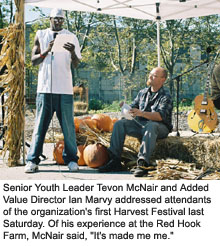
It's the type of symbiotic partnership that Added Value has built upon from its inception. French restaurant 360 was one of the farm's earliest customers when it opened on Van Brunt St. in 2003. Restaurant E.C. on Dekalb and Vanderbilt also buys the Brooklyn-grown greens.
Added Value has another friend working in Washington D.C. U.S. Congresswoman Nydia Velazquez secured $112,500 last summer allowing the organization to pay stipends to the teenagers that work the land, like Senior Youth Leader Tevon McNair. The grant also led to the hiring of full-time Community Education Coordinator Caroline Loomis who welcomes hundreds of school children throughout the summer.
Beyond hands-on agriculture, the organization runs a program called Digital Horizons. Phil Shipman helps run the desktop publishing and media literacy classes. Shipman explained the connection between the farm's mission and savvy media consumption.
"Of the $16 billion of ad revenue spent advertising to kids every year, $11 billion is spent on food advertising," Shipman said. "Pringles alone spends $19 million. Coca-Cola $666 million." Comparatively, the National Cancer Institute budgets $3 million to promote the health benefits of fruits and vegetables.
"So we're trying to push back a little."
The empowering nature of the work is evident in the presentation skills of the Youth Leaders. On Saturday high schoolers Dania Cuello and Richard Taurez presented their findings of a research project they conducted in the neighborhood recently. They went into all grocery and corner stores in the neighborhood to see what was more available: candy or vegetables (for the record candy 20, vegetables nine).
For McNair, the event marked the end of four years with the organization. The Bedford-Stuyvesant resident will graduate from Manhattan's Satellite Academy in the Lower East Side and plans to attend college next fall. He talked about what the experience has meant to him.
"It's taught me skills that I'll use in the real world like getting up in front of people and expressing my ideas," he said shortly after addressing the crowd. "It's made me me."
Accomplishments like these are hard to measure. But with the success of Red Hook's first Harvest Festival and the potential of the upcoming planning session, the fruits of Added Value's labor are nonetheless apparent.
The organization's mission is lofty, its premise is simple. "Not only should business not denigrate the environment," Marvy explained. "It should benefit it."
As a business, Added Value adheres to a philosophy that Marvy called the "triple bottom line." The first bottom line is economic profit. The second is the social bottom line, measuring a business's positive or negative impact on society. And the third bottom line is environmental.
"Food, in its essence, is about creating community," Marvy said. "Producing food should be about creating justice."
Red Hook has historically been left to its own devices, for better or worse. Now that's changing with the property values, but Red Hook remains a unique mixture of incomes, races and industries. For the foreseeable future, organic agriculture will be part of that mix.
|
Beard St. studio unveils renovated rental space
|

|
(Photo provided by Red Productions Inc.)
|
As Manhattan became cost-prohibitive for small shipping enterprises in the mid-1800s, developers like Robert Beard built Brooklyn into "The Walled City." Today, creative industrialists like Red Productions Inc. have found room to grow within those walls. The Beard St. photo studio is now offering a newly-renovated space to local creatives for daily or long-term rental.
The original 1869 beams stand prominently throughout the warehouse. A skylight runs the length of the 16-foot-high ceiling allowing natural light to flood the 1,800 square-foot rental space. Hardwood floors, exposed brick and a fireplace also highlight the studio.
Last year Steve Hellerstein, founder of Red Productions, migrated from the Chelsea space he occupied for the last 15 years. His clientele has followed him to Red Hook--with the help of a few trusted car services.
"Some have heard that it's a hot area," Hellerstein says of their preconceptions of the neighborhood. "But others, when you say Red Hook, they just hear 'Not Manhattan.'"
Hellerstein's portfolio, however, is flush with award-winning Madison Avenue work for brand-names like Evian, Heineken and DeBeers. Down the hall Jerard Studios builds props for Broadway shows like Spamalot and The Producers. In the adjacent warehouse on the pier the Blue Man Group stores scenery and glass is handblown on the ground floor at Pier Glass.
The artistic nature of the 40 businesses operating in the Beard St. Warehouses have little in common with the shipping and warehousing tenants of the 19th Century. But 186 years later, the nature of Manhattan's small business landscape is the same. And Robert Beard's walls are full.
For information about renting space at Red Productions Inc., call 718-243-1410.
|
City holds dry run for cruise industry at Pier 12
|
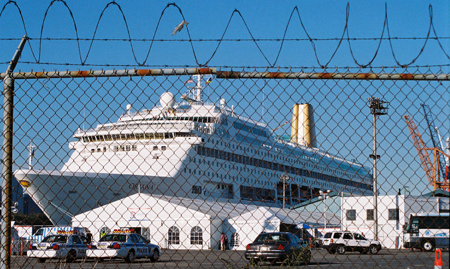
|
(B61 Photo)
Originally posted Sept. 26, 2005
|
|
On an otherwise typical fall Saturday, New York City's power elite descended upon Red Hook for the first docking of a cruise ship in Brooklyn. The Oriana, a P&O luxury liner, sailed in from London escorted by fire boats as Mayor Michael Bloomberg, Borough President Marty Markowitz and members of the city's Economic Development Committee arrived on a newly-blacktopped service road behind the 160 Imlay St. development.
En route to Boston, Halifax and Quebec, the 853-foot Oriana's docking provided the first tangible evidence of the city's vision for a $47 million passenger ship terminal at the pier. For Saturday's photo op, a temporary terminal was erected and several dozen police officers patrolled every entrance from piers 6 through 12. By Sunday afternoon the structure had been dismantled. A few clusters of colored balloons remained in the otherwise empty lot adjacent to the garbage transfer site on Conover and Sullivan Streets.
The permanent terminal is scheduled for completion in April and will accommodate luxury liners as large as the 1,132-foot Queen Mary II. Many local businesses expect to benefit from such visits. The QM2, for example, carries 3,900 potential shoppers and diners. However, an informal poll of service workers in the area revealed no increase in foot traffic or business this Saturday as tour buses transported people from the site to Manhattan.
While the Oriana and the Mayor's visits were fleeting, there were enduring signs of related development in the area such as a new tree-lined sidewalk on Pioneer St. from Van Brunt to Conover Streets.
|
Books put basketball in perspective
|

|
Books and Basketball is in its fifth season of tying athletic participation to literacy. Red Hook Rise organizers have seen growth in the program while demanding more from its participants. (B61 Photo)
|
|
|
COFFEY PARK--The referee's whistle blew sharply inside the cage at Coffey Park. "Thank you!" yelled a 10-year-old boy who felt the foul call was long overdue on this 90-degree Saturday. It was a moment on a hot blacktop basketball court that could easily have turned into a bigger outburst from the player or the ref. But it didn't.
"That's enough!" was all the referee said. The conversation ended. The competition resumed. As time expired, one team celebrated, the other was disappointed.
To an outside observer strolling through Coffey Park on a Saturday, Books and Basketball looks like any other athletic league for 7- to 13-year-olds. And it is, except for one difference--players have to spend 20 minutes reading before or after their game, or they can't play.
The reading requirement was a simple response to a complex problem that the organizers at Red Hook Rise tackled five years ago.
"A lot of kids were having trouble filling out the application for the basketball program," explains Director of Operations Lori Bethea. The organizers installed a "literacy first" policy and demanded that a parent or guardian accompany the children on sign-up day. Asking more from the players and parents has paid dividends.
"It's made a big difference. The kids are more focused," says Bethea. "There's been a tremendous amount of improvement in their behavior. They're more respectful and encourage one another to read."
Lori's 16-year-old son Raymond played in the league before the reading component was added and now volunteers with the organization.
"Before 'Books' everybody was just playing to tighten up their game and become 'nice'-- that's what they call it," Raymond says. "There was more bickering and fighting about who's best. But now it's a lot more settled down, and there's a lot more kids."
Since 2000, participation has increased from 60 to 172 kids this summer. Parental involvement has also increased. This year 17 parents volunteer every week compared to six when the new policy went into effect. Another eight community members lend their time coaching, cooking, refereeing and organizing games and reading sessions.
One of those community members is Murray Hanson, the man with the whistle. Hanson, a legend among local youth organizers, is in the best position to see the changes. But for the Red Hook native, the story goes back further than 2000.
"There were some tough times," he says of the 30 years he's coached and ref'd in the community. "Red Hook was on the cover of Life Magazine [Crack: downfall of a neighborhood," July 1988]. Other coaches with teams didn't want to come down here. But we got through that."
Hanson credits Red Hook Rise founders Earl and Ray Hall for helping the community weather New York City's crack cocaine binge of the late 1980s and early 90s. "It's still not all peaches and cream. But they have solidified a brand new perception of Red Hook. They've helped a lot of people rethink what's possible in their lives. They've worked hard."
The hard work has gained the notice of politicians and businesses who have whole-heartedly embraced the new perception of Red Hook. When IKEA decided to pursue a store in Red Hook, they sought the Hall's help. When Fairway opens their doors on Van Brunt Street at the end of the year, Red Hook Rise will have office space upstairs donated by developer Greg O'Connell. A recent Saturday, Julius Spiegel, Borough Commissioner of Parks addressed the kids. And Borough President Marty Markowitz will appear on the last day of the season, Aug. 13.
All the attention this election cycle is new to a grassroots organization that was born out of Red Hook's hardship. "It's about time," Earl says. "They all say that education is a priority. And now here's a program that they can be a part of that challenges them to back that up."
The Halls' commitment to the neighborhood began long before Red Hook appeared on the political and real estate landscapes.
"We lost friends to the street. We lost relatives. We were fortunate to walk away without getting incarcerated or shot or stabbed. It was a wake up call for us to give back. To get the community to come together and unify and say, 'We don't have to continue to let the cycle affect us,'" Earl says.
To give kids something positive to do, the Halls began recruiting players for touch football games in 1994. They concentrated their efforts on at-risk teenagers, whom they found easy to identify.
"You can always find kids just hanging out in the street. Not doing anything." Earl says. "It's not hard to find the at-risk kids."
The growth of Red Hook Rise has coincided with several positive trends in the neighborhood. Crack cocaine's popularity has fallen along with the area's crime rate. Overall crime in the 76th Precinct has declined 56 percent since 1993, including an 87.5 percent drop in murder. Statistics like these tell a feel-good story that has made Red Hook a prime candidate for political photo opportunities. But the community still has real problems.
According to a report released by New School University, the median annual household income in Red Hook Houses was $10,372 in 1999. Consider that number with the fact that 25 percent of residents were between the ages of 5 and 14, and it adds up to a vulnerable population.
While the original football games concentrated on teens already on the street, Books and Basketball aims for this younger demographic. The goal is to reach kids before the street does. Judging by the rapid growth of the program, it's clear that Red Hook Rise has found an eager audience for its message.
"This is where it began," Earl says looking out over the lot between the basketball court and Richards St. "There was nothing here but solid cement, broken glass and debris. It was just a vacant park."
To anyone who has worked with youth in South Brooklyn for the last decade or more, it looks like a much different place. But as the neighborhood undergoes dramatic change, Hanson stresses, "Don't ever forget where you come from. Red Hook has an incredible history."
For 172 kids, that history includes learning to read in Coffey Park this summer.
|
On board the dredging of Buttermilk Channel
|

|
A unique oceangoing hopper dredge is currently operating off Red Hook's shore. Dredge McFarland stretches over 300 feet and has been enlisted to remove 100,000 cubic yards of material from the bottom of Buttermilk Channel. View the slide show. (All photos by B61) Originally posted July 20, 2005 Acknowledgements: Coordination between PortSide NewYork and the United States Army Corps of Engineers, Philadelphia District made this report possible.
|
BUTTERMILK CHANNEL--Amid the bustle of New York Harbor, the United States Army Corps of Engineers is quietly going about their business of maintaining the waterways for whatever developers and the City decide to throw at Brooklyn's waterfront--cruise ships, cargo, breweries, whatever.
On board the 319-foot Dredge McFarland, Senior Captain Karl Van Florcke tries to explain the current project as it's laid out on survey maps. "The 30s need to go down to 35, and the 37s go to 40." To the untrained observer the intricate charts might as well be Magic Eye posters, except they remain blurry even after your eyes cross. The bottom line is that the Buttermilk Channel must be deepened from 31 feet to 40 feet to remain a safe waterway for large vessels. It's routine maintenance that takes place about every five years.
For twelve minutes at a time, the dredge collects 1,000 cubic yards of mud. Quartermaster Tom Trader steers the vessel with 2nd Mate Jim Davidson to his right and 3rd Mate Bob Mason to his left. Davidson and Mason monitor traffic on screens that answer who, what and where on each and every vessel in the Harbor. Off to the side a grandfatherly marine biologist studies a laptop computer.
By the end of an afternoon aboard the ship, the survey map begins to look like an oversimplification of Dredge McFarland's task.
Two weeks on
"It's tough to find qualified people," Captain Van Florcke said of the maritime industry's labor market. "So you have to produce your own good guys because every dredge has their own idiosyncrasies."
Along with Captain Thom Evans, Captain Van Florcke oversees 35 men. The entire crew lives and works aboard the ship for two weeks straight, followed by equal time off in their respective Atlantic Coastal towns. The ship operates 24 hours a day. Some of the McFarland's crewmembers have manned their posts in this rotation for 25 years.
"It's a great lifestyle," Capt. Evans said walking past the living quarters of his crew. The rooms are comparable to dormitories, but clean. "There's always a pot of coffee on and someone to talk to. And the food is excellent."
The ship circles as it collects its next load. In the next four hours the McFarland will make a 40-mile round trip to dispose of the load beyond the Verrazano Bridge--barely exceeding 15 mph.
It's a cycle that the Philadelphia-based McFarland and its civilian crew repeat over and over 24 hours a day, in all kinds of weather, from Maine to Texas. Just as they did at the mouth of the Mississippi River before this, and as they will for Trenton, NJ afterwards.
Turtle People
In one year the ship will dredge enough material to fill a football field three-quarters of a mile high. The current project will add 100,000 cubic yards of sand, silt, and anything else New Yorkers throw into the mix. On this day a very pungent, spongy Butterball Turkey was removed before it reached the interior of the ship's hull, called the hopper.
The job of cleaning the filter falls to biologist Brad Davis. "I'm the guy who deals with everything you New Yorkers put in your river," he says. Even the dirty work aboard a dredge doesn't compare to what Davis experienced in his previous job. As a police officer in Austin, he investigated crimes committed against youth.
"That takes a toll," he alluded to things he encountered in a 10-year law enforcement career. Things he would clearly rather forget. "You can't do it for very long. So now I'm out here trying to help critters."
While the rest of the crew is busy with the mechanics and logistics of moving 4,000-5,000 cubic yards of mud a day, Davis and his mentor Ned Clement (the man at the laptop) are the eyes and ears that allow the brute force of the dredge to coexist with sea turtles and whales. Endangered species inspectors, such as Davis and Clement, are independent contractors who are legally required to monitor all dredging operations. They are not always on the same page with the rest of a dredge's crew.
"A while back one of the turtle people--that's what we call them--was worried that she was contributing to nuclear war. Because we were dredging down at Cape Canaveral and they have a submarine base there," Capt. Van Florcke recalled. "But I told her, if you don't do it, a turtle might get killed."
Fewer turtles have been killed thanks to a device that was developed on the McFarland. The "turtle excluder" funnels turtles (or once-frozen turkeys) away from the hopper where they would meet certain death. The device is now required on all dredges.
"It's cool to be on the ship where that technology was developed," Davis said. "I've never been on a dredge where the crew was as cooperative and diligent about protecting the environment as they are on the McFarland."
The Flying Bridge
The far off sound of a ship's horn is a soothing aspect of life near a major waterway. It's not soothing, however, when you're standing five feet away from it on the top deck, known as the "flying bridge."
"Hey," Capt. Van Florcke yelled down to the bridge through a tube. "I feel like I was just at a Who concert!"
On the flying bridge, satellite antennae sprout up every few feet like slalom flags facilitating the flow of information to and from the 38-year-old ship. They feed the Captains' Blackberry PDAs, maritime-specific weather programs and the laptop that receives Clement's undivided attention directly below.
At sixty feet above the water, the deck offers a rare perspective on New York Harbor. From right to left, Red Hook comes into view. The McFarland has been here before. One of the visits was to the graving dock in the Erie Basin, which is slated to become IKEA's 1,400 car parking lot.
"That's too bad. There aren't enough of them. Especially around here," Capt. Van Florcke said. The McFarland goes into drydock every other year.
The Captains each raised an eyebrow at the suggestion that dredging is free of the politics that grip landside waterfronts.
"Dredging doesn't have politics?" Capt. Evans asked rhetorically.
Among the government agencies that take an active interest in the McFarland's activities are the Environmental Protection Agency; Department of Interior, Fish and Wildlife; Department of Commerce; National Marine Fisheries; Coast Guard and Department of Environmental Conservation.
Indeed, dredging has its own politics. In 1978 the U.S. Congress passed legislation that prevented the Army Corps from competing with private industry for some dredging projects. The result has been mothballing of some Army Corps dredges to benefit private industry.
One private project underway is an effort to deepen New York and New Jersey's waterways to 50 feet. The improvement project is to prepare the Port for the rollout of Post-Panamax vessels. These new cargo ships are so big they can't fit through the Panama Canal. Their behemoth size is a manifestation of the shipping industry's effort to keep pace with ever-increasing amounts of imported products coming into the United States.
Key decisions are yet to be made about the best use of Red Hook's waterfront. Cruise ships will port at pier 12 with an eye towards 11. American Stevedoring Inc.'s lease for piers 7-10 expires in 2007. And the Brooklyn Brewery has expressed interest in moving from Williamsburg to pier 7. So this section of the Harbor will be dealt with in phase two of the 50-foot project. The entire undertaking is scheduled to be complete in 2014 at a cost of $1.6 billion.
The return trip
The Captains huddled around Clement and his laptop. The computer tracked the ship's movement as it approached the dump site. Clement clicked his computer's mouse and the hopper very precisely emptied into a predetermined 100 by 200 foot area 10 miles off shore in the Atlantic Ocean.
Another segment of the survey map was deepened and a couple cigars were lit as the two-hour return trip began.
"That's my old man," Capt. Van Florcke, a Patchogue, Long Island native, pointed to a black and white military headshot on the wall of his living quarters. Both father and son graduated from the United States Merchant Marine Academy at Kingspoint College. He reached into the top shelf of his closet and presented labeled Ziplock baggies of soil samples. "I keep these. I don't know why." The Buttermilk Channel's sample was drying in a pan on the desk.
Each packet shows the variety of soil found along the Eastern seaboard. From the brown silt of Maine to the white sand of the Gulf Shores, Capt. Van Florcke's collection provides an earthen timeline of the McFarland under his 22-year command.
"There have been times, where I thought 'this ship is the only thing between me and some deep [trouble],'" he said reflecting on harsh storms the McFarland has endured in the line of duty. "You get protective. It's like you don't want anybody to say anything bad about her."
It's hard to find a bad word to say about the ship or her buttoned-up crew. For a project of this magnitude, this close to Red Hook's shore, that's saying something. As New York City's decision-makers adhere to obscure charts of their own to remake Brooklyn's waterfront, at least one thing is certain: the Buttermilk Channel is once again a safe 40 feet deep.
|
Local families feel impact of City's cuts in day care
|
|
|
Out of School Time represents a shift in funds and focus by the City to address day care and after school needs of residents. Several Red Hook parents are struggling to adapt to the cuts.
|
By Sara Stefanini
|
Since the first week of September, when the Red Hook day care center she had been using for more than four years was forced to close one of its after-school classrooms, Luz Gonzalez has been scrambling to get her 10-year-old daughter into the program at Public School 15.
Gonzalez, a substitute teacher at the Salvation Army's Fiesta Day Care Center, where she had been sending her daughter, believes the P.S. 15 program is a better option than the city's new system of after school programs, called Out of School Time.
"It's terrible, it's inconvenient for all the parents," Gonzalez, 45, said of the city's move from supporting private day care centers to granting contracts for community based organizations to start programs that follow the OST guidelines.
Gonzales refuses to send her daughter to the OST program in Red Hook, offered at Public School 27, because she believes the program will have so many students her daughter would not get the attention she had at Fiesta Day Care, where two teachers looked after a maximum of 23 students in her daughter's age group. Her daughter is currently on the waiting list at P.S. 15, where two or three teachers oversee groups of up to 27 students.
OST guidelines require a minimum ratio of one staff member to 10 students for the younger grades, Christopher Caruso, assistant commissioner of OST programs, wrote in an e-mail message. At P.S. 27, 25 staff members watch over about 200 students.
Fiesta Day Care lost funding for its class of 17 children nine to 12 years old this year, and will probably lose its class of six- to eight-year-olds next year. Both classes run from 2:30 p.m., when teachers pick students up from school, to 6 p.m. The center also offers day care during school vacations.
The city's new options for after-school day care--the OST programs or vouchers with which parents can find their own caretakers--are unappealing choices, Gonzalez and other parents say. OST opened in September with a projected enrollment of up to 50,000 elementary, middle and high school students in 400 programs citywide, according to the Department of Youth and Community Development. The department says the program is a way for the city to streamline after school services and their accountability by bringing them together under a set of guidelines it has designed to ensure the programs offer a mix of academic and recreational activities. Parents and teachers worry that the programs will have young, inexperienced staffs supervising overcrowded classrooms.
Finding a trustworthy caretaker with whom to use the vouchers is also a challenge for many Fiesta Day Care parents, said Ruth Bumanlag, the center's director. About 10 percent of families live in the Red Hook Houses and many others live in single-parent homes, she said.
Lizzette Ramos, a home health aid whose 10- and 5-year-old daughters attended Fiesta Day Care, laughed and rolled her eyes when asked if she thought of using the vouchers. "I don't have anybody I can trust," she said, adding that the people she could trust already work. Like Gonzalez, Ramos, 28, began sending her older daughter to P.S. 15 when her Fiesta Day Care class closed.
The Department of Youth and Community Development announced this summer that over the next two years it will replace its contracts with 168 school-age childcare services, like Fiesta Day Care, with OST – the largest municipally-funded after-school system in the country. In the next few years, the department estimates that 550 OST programs in schools and community centers will be serving at least 65,000 students (an average of 118 students per program). Funding for the programs this year is $47 million, and will grow to $75.6 million in 2007, Caruso said.
"OST will offer youth a wide range of activities and services, including academic enhancement, life skills, community building, physical recreation and arts and culture," he said.
Critics of the OST programs argue that because it offers lower wages and less benefits than most private programs did, its staff will mostly be teenagers with little experience.
"I absolutely think it was a mistake," said Andrea Anthony, executive director of the Day Care Council of New York, an organization of nonprofits that is helping day care centers find other sources of funding to keep their after-school programs open. "I think it's a sham, it's shameful."
While private day care centers in New York City, spend $4,000 to $5,000 a year per child on average, OST will have about $2,800 per elementary school student and less for middle school and high school students, Anthony said. "You're cutting the funding, cutting the staff, so what kinds of activities can you possibly have?"
Staff members at the OST program in Red Hook, sponsored by Good Shepherd Services, a social services agency, are mostly former students from the program who have been trained for the positions, said Clara Delgado, the program's assistant director.
Students five to 13 years old attend after school from 3 to 6 p.m., Delgado said. The staff helps students with their homework for the first hour, then moves on to activities such as arts and crafts, sports or dance.
But Melvin Stewart, director of day care services for the Salvation Army of Greater New York, worries that OST will place much less emphasis on educating students.
"I'm fearful that it's going to be a glorified babysitting program," he said. The Salvation Army's other after-school program, in East New York, Brooklyn, also lost its funding, he added.
Benny Vasquez, who until this year taught Fiesta Day Care's class of nine- to 12-year-olds and has a degree in early childhood education, said he emphasized reading and building students' vocabulary during class, and would not let students play until they finished their homework.
Vasquez and his fellow after-school teacher have now filled two open positions in the center's day care classroom for two- to five-year-olds, said Bumanlag, the director. Bumanlag worries that closing the second after-school class next year will be a devastating blow, because she would lose two other teachers, one of whom is also the assistant director.
"That is why I am motivating my staff to go back to school, get degrees," Bumanlag said. "We do not know the future of day care centers now in New York."
|
IKEA sides struggle to hear, be heard
|
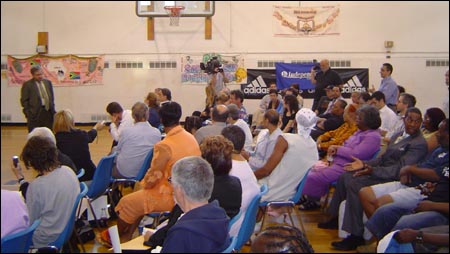
|
The PAL Miccio Center's gymnasium accommodated a large audience for IKEA's "next steps" presentation to Community Board 6. By the end however, only 11 board members were present to vote on a resolution that skirted the issue of whether the graving dock can coexist with IKEA's 350,000 sq. ft. furniture outlet. And specific details of the asbestos remediation plan were put off for a future meeting. (Photo by Jessica Dheere)
UPDATED 10:57 p.m. JUNE 29, 2005: New York State Supreme Court Justice Karen Smith has ruled against the plaintiffs in a suit that claimed the City of New York failed to effectively evaluate IKEA's Environmental Impact Statement before approving the Red Hook project. IKEA spokesman Joseph Roth said today: "We are pleased with the court's decision to dismiss the lawsuit against our project in Red Hook, Brooklyn...As we have done throughout the development process, we look forward to continuing to work closely and cooperatively with the community on these efforts."
Originally posted June 27, 2005
|
RED HOOK-- "This is not Act II of a play," said Community Board 6 Chair Jerry Armer in his opening statement to last Thursday's joint session of the Land use/Landmark and Economic/Waterfront Development Committees. "I'm afraid you're going to be disappointed."
Armer was speaking to those in the audience who hoped the board would take a stand one way or the other on alternative site plans that would preserve the working graving dock at the Beard St. property. IKEA intends to turn it into a 1,400 car parking lot.
The presentation to the board was also IKEA's first since purchasing the Beard St. property earlier this month. The previous owner, U.S. Dredging Corporation, was slapped with several violations related to handling of asbestos during a demolition in January. It was the first opportunity board members and residents had to question IKEA's asbestos remediation plan since then.
Board member Lou Sones was among those disappointed by the Chair's decision to limit debate on the graving dock. "Jerry Armer changed the rules and moved the goalposts," he said. Sones had renewed the graving dock debate at an Economic/Waterfront Development committee meeting on May 2.
A motion was passed that night to discuss alternate site plans from the Municipal Art Society which would allow the store and the graving dock to coexist. At the following general board meeting on May 11, the motion was ruled out of order by Armer on procedural grounds. Because IKEA's plan was originally approved by the Economic/Waterfront Development Committee, any potential change to that approval would need to come out of that committee, Armer said at the time. The general board voted to address the graving dock/parking lot issue in a session involving both committees.
But when Thursday's meeting began, any possibility that the board would act to save the graving dock disappeared in Armer's statement.
The vague wording of the motion left plenty of room for confusion about the purpose of Thursday night's meeting--confusion that was exacerbated by the acoustics of the PAL Miccio Center's gymnasium. Originally scheduled to take place in the Center's cafeteria, the meeting was moved to accommodate the audience of 60 that included board members, residents, city-wide media and concerned preservationists. Despite the setting, no microphone was used so many statements were inaudible as the discussion shifted from one side of the basketball court to the other.
Among those who struggled to have his voice heard was Municipal Art Society Senior Vice President Frank Sanchez. He was prepared to present alternatives his organization developed to save the graving dock, but Armer announced the meeting would be strictly an informational meeting presented solely by IKEA.
"We cannot vote on something that's already gone," Armer said. "It's done." He was referring to the board's approval of IKEA's project. The 710-foot graving dock is still present and intact. Until IKEA took ownership of the property it had been in use since being built in 1866 and is listed as one of the New York Preservation Society's "Seven to Save."
"This committee and this board has historically been pro a working waterfront. A graving dock is integral to a working waterfront. There are precious few of them and there's a tremendous up tick in waterfront activity," Sones said as he attempted to introduce a motion that would force the committee to take a position on the matter.
Jesse Masyr of the law firm Wachtel & Masyr represented IKEA and explained that the company deemed both MAS's plans unviable. One would require IKEA to purchase a plot of land at the end of Columbia St. Masyr said that they had originally wanted to own the plot, but they "couldn't afford" the seller's price. IKEA recently purchased the surrounding property for $31.25 million.
The second alternative plan calls for an underground parking structure. John Clifford of the law firm Greenberg Farrow explained that the plan would require an elevator, which is unviable due to the large size of IKEA's merchandise. Also the second alternative would introduce a ramp at an untenable angle for delivery trucks, Clifford said.
MAS's Sanchez said that he would be happy to address these issues. Committee Chair Pauline Blake then suggested the board could recommend that IKEA open a dialogue with MAS. Sanchez was pleased with the idea. Masyr did not respond.
David Sharps of the Waterfront Museum argued passionately in favor of the graving dock. "As neighbors we are desperately pleading with IKEA to try to recognize the potential, which I don't think you realize it has."
When prodded by Armer to expand on his position, Masyr said, "Any change to the site plan puts us back to the very beginning of the process...we'd have to do it all over again as if we didn't go through it in the first place." No doubt, that is a scenario welcomed by opponents of the project.
But concern over asbestos and support for the graving dock are not limited to anti-IKEA activists. MAS's plans have garnered endorsements from United States Congresswoman Nydia Velazquez, State Senator Velmanette Montgomery and City Councilman David Yassky.
Velazquez wrote directly to IKEA regarding asbestos, the use of union labor and the graving dock. IKEA never responded to the U.S. Congresswoman.
When Sharps, asked him about Velazquez's letter, Masyr responded "I don't know what you're talking about."
Dan Wiley, Velazquez's Community Coordinator, read from the letter. Still Masyr did not address the concerns. Instead, Armer fielded the question and explained that the full remediation plan would be discussed at a future Public Safety/Environmental Protection committee meeting and pointed out that IKEA was not named in the violations.
Board members Elsie Felder and Devin Cohen each pressed the asbestos issue. Felder first asked for an update on the asbestos situation.
"The asbestos technically, not technically, legally does not involve IKEA," Masyr said alluding to violations levied at the property in January. "It has to do with actions taken by U.S. Dredging."
"I can assure you that I don't think you'll find anybody right now that is more sensitive to that issue than we are," Masyr said in response to Cohen who chairs the Public Safety/Environmental Protection Committee. He added that there would be a full remediation of asbestos at the site. That has been IKEA's stated position since their original Environmental Impact Statement was drafted in 2002. But they have refused to comment on whether they feel U.S. Dredging's handling of asbestos was proper.
After the meeting Felder expressed regret for not asking, "But now is it your responsibility now that you have taken ownership of it?"
When informed of Felder's follow-up, Masyr stated, "What you're talking about is a violation of a practice that's controlled by the environmental law of the city that has to do with procedure. And we have no 'nexus' as the law would say, to that." He did confirm that U.S. Dredging would not have a role in the demolition moving forward.
The two CB6 committees have 40 members combined. But in the end, only 11 were present to vote on a motion that recommended a meeting between IKEA and MAS to discuss alternative site plans. The motion did not advocate a position, and passed nine to one, with one abstention.
|
Red Hook's rhythm rushes inland
|

|
Extraordinary talent was on display in Red Hook this weekend. From break dancing to live theater, a celebration of the neighborhood's relationship with water transformed the peninsula into one large performance space. The range and rapidity of events put a serious strain on the constitution of our Society page staff (B61 Photo).
|
RED HOOK--The revolutionary war began on it. Dueling community groups now trade insults over it. And outside developers expect to have their way with it. But this weekend residents celebrated a relationship with South Brooklyn's waterfront, setting off a flood of creativity that didn't ebb until Sunday evening.
As an impromptu prelude to the weekend a blues singer/guitarist wandered into Lillie's late on Thursday night. Calling herself only Alicia, she proclaimed, "I'm trying to be professional, but I can't quite manage it yet." The polish that she lacked on stage had nothing to do with her crackly voice or fret work. With a repertoire heavy in Leadbelly and Robert Johnson, Alicia is the type of artist found only on the fringes.
The Red Hook Waterfront Arts Festival emanated from the Beard St. Pier on Saturday. Sponsored by Dance Theatre Etc., the fest attracted streams of visitors throughout the day. BWAC benefited as it drew 1000 people on Saturday alone. The Youth Film Festival was especially eye-opening as teenagers presented near-professional documentaries. One film from Made Ya Blink Productions presented a balanced dialogue and perspective of a changing Red Hook. KR3TS Dance Company, led by two-year-old break-dancer Noah Paul Galagarza, was the highlight performance on the pier.
As the crowd filtered inland, much of it collected in Coffey Park for a performance by Rennie Harris Puremovement presented by Dancing in the Streets.
The biggest surprise of the weekend was "Blow me down! The daring exploits of Spanish John, Pirate" at the new outdoor Coffey Street Playhouse. The backyard spectacle, written by St. John Frizell and directed by David Teague, ended its two-day run on Saturday night in front of a standing-room-only crowd of 130. The smart, quick-witted script and professional production-value made it difficult to classify the five-act romantic pirate comedy as "Community Theater."
Sunday the performances shifted to the end of Conover St. On the east side of the street three authors presented work at this month's Sunny's Reading Series. Todd Hasak-Lowy, aided by friends Matthew Rohrer and Josh Lewis, read "The Interview" from his collection of short stories "The Task of This Translator." The piece was a satire on the initiation into corporate culture.
Novelist Alicia Erian raised the temperature in the already-sweltering bar as she read a provocative piece from her first novel "Towelhead." Any synopsis would violate B61's family-friendly philosophy. But the book has been optioned for film by Alan Ball, creator of the HBO series "Six Feet Under."
Investigative journalist Katherine Eban delved into the black market prescription drug trade in Florida reading from her book, "Dangerous Doses: How Counterfeiters Are Contaminating America's Drug Supply." It's a true story that she described as "Scarface meets Duane Reed."
Across the street, bicycles and strollers lined up outside the Waterfront Museum and Showboat barge for the much-anticipated return of CIRCUSundays. Captain David Sharps will host world-class circus talent for three shows every Sunday in June.
And finally there was Open Studio 2005...which we regretfully missed altogether. But we heard glowing reviews, especially of oil paintings by Michael Prettyman.
In the end, this weekend's festivities did nothing to heal the open wounds related to waterfront development. And next year the impact from those decisions will be more evident. What is apparent, however, is that today's Red Hook shares an incredibly deep pool of creative talent.
|
Roselli draws simplicity from complexity
|

|
Mimmo Roselli has left his mark all over the world. His latest work "Drawing Space" is on display at Kentler International Drawing Space through June 25 (Photo courtesy of Florence Neal).
|
RED HOOK--"The line is the trace humans make passing in this world." That's how artist Mimmo Roselli describes his life's work. He has traced that line across the globe and now it has reached Van Brunt St. at Kentler International Drawing Space.
As three simple lines etched into Kentler's wall, the impact of "Drawing Space" is not from the subtle, monochrome visual itself, but from the broader contexts of environment and the artist's career. Roselli explained his fascination with "borderline communities" to an intimate gathering last Saturday afternoon.
"There's special strength in populations that live on borders," he observed. Sometimes that has meant geographic borders such as a Bolivian village where he worked with schoolchildren just west of Brazil. Other times it has been abstract borders such as a retirement community in his native Italy. In either case, Roselli has chosen to work in communities "where people pass from one place to another." Red Hook now joins that list which includes Chechnya, Venice, Heidelburg and Rio de Janeiro, to name just a few.
His experience in the Bolivian village was especially influential. "I saw how we spend our life consuming. They want to respect nature, never taking from nature over their necessity. They don't know accumulation."
Roselli's appreciation for the simplicity he has observed in his travels is reflected in his minimalist approach to art--triangles symbolize solidarity, white conveys serenity.
Working with the environment, Roselli has created installations where the line, or the "sign" as he refers to it, was represented by cables that made physical connections between earth, trees and buildings. He has also etched his sign into stones displayed in an Italian cathedral.
"Drawing Space" may be imperceptible to anyone in a hurry as it encircles the white walls of Kentler's gallery. True to the conceptual form of art, the installation will potentially mean profoundly different things to every viewer--just as the changes that affect our own "borderline community" will affect everyone differently.
Slow down or you might miss it.
|
Menchetti dominates hotdog eating contest
|

|
Brooklyn Borough President Marty Markowitz was the first to congratulate Joe Menchetti for winning the first Stahl-Meyer Hot Dog Eating Contest. Schnack hosted the event on Memorial Day (B61 Photo).
|
COLUMBIA ST.--The competitive-eating Universe revolved around Schnack this Memorial Day and one star clearly shone brightest. Electricity filled the sidewalk air at 122 Union St. as prominent news outlets UPN and WB trained their lenses on the field of five. The anticipation of fifty eating fans built as the rules were read and came to a crescendo as the eating commenced.
While participants were not professional competitive eaters, each man had proved his worthiness in preliminary rounds. But only one man made history in this first Stahl-Meyer Hot Dog Eating Contest. Joe Menchetti raced to the finish of a 30-inch hotdog (the equivalent of five normal-sized dogs) in a tidy one minute, 30 seconds--a blistering rate of three seconds per inch.
While he washed the food down with a Jever Pilsner, the beverage could not cleanse his palette of victory's sweet aftertaste. Menchetti proved there was just room enough for one at the top. However, he had room for a standard-sized Stahl-Meyer hotdog as everyone else turned their attention to the race for second.
Undeterred, Arnie Chapman ate his way to redemption, finishing second in a very respectable two minutes, 10 seconds. Any other day, perhaps, it would have been Chapman, not Menchetti, who would have his arm raised in triumph by Brooklyn Borough President Marty Markowitz. But not today. Today the spotlight rested squarely on the beaming Joe Menchetti.
For the vanquished, there was no solace to be found in Manchetti's considerable shadow. Faced with the uneaten remains of their respective hotdogs, they were left to wonder "What went wrong?" It's an image that is sure stay with the competitors as they train for next year.
Menchetti, meanwhile, was showered with praise and prizes from sponsors Ferris Stahl-Meyer, Jever Pilsner, Caputo Bakery, American Stevedoring and New York Waterways. It wasn't the first time eating has provided the Connecticut man with more than sustenance, and this may not have been his biggest prize. "Friends of friends haven't always had a lot of faith in what I could do," he said of the many bets he has won with his eating prowess. Now all of Brooklyn knows what Joe Menchetti can do.
|
NYCHA lawsuit revolves around open door
|
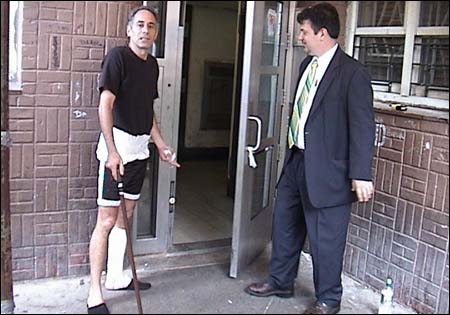
|
By nearly every objective measure, life in Red Hook has improved dramatically. So why is this Red Hook West tenant so mad? The short answer: this door. Related to a May incident, Eddie Franco (left) and his lawyer Jonathan Vitarelli (right) are seeking damages from the New York City Housing Authority. (B61 Photo)
|
RED HOOK--Bruised and battered, Eddie Franco appears to be in no condition for a fight. But after tripping over bricks that were propping open the door to his apartment on May 2, Franco's frustration has reached a boiling point. At first glance his lawsuit against the New York City Housing Authority seems like a typical "slip and fall" case. But Franco himself had made previous complaints to NYCHA about the very conditions that led to the fall. Conditions that he says allow drug dealing and prostitution to take place in his building.
Tenants at the Gowanus Houses also raised the issue of damaged doors at this month's community council meeting. In that case, complaints allege screws had been removed from hinges preventing doors from closing completely and allowing non-residents unfettered access to the building 24-hours a day.
Wally Alvarado, Community Liaison for City Councilwoman Sara Gonzalez, contacted NYCHA and the 76th Precinct after Franco spoke at last week's Red Hook West tenant meeting. Alvarado says that he has received assurances from NYCHA that the door lock will be fixed this week and that NYPD's narcotics division will investigate Franco's claims that illegal activity is rampant in his building.
The response is little comfort to Franco. The Red Hook West apartment door has not locked in the 10 years Franco has lived there, he says. After complaining in 2001, Franco claims he suffered retribution.
"Someone called the police and told them that I was the one selling drugs," Franco says. "Cops busted down my door and put a gun to my head at six in the morning."
After searching the apartment the officers realized drugs were not being sold out of his apartment and apologized, Franco said.
He complained again in February of this year. Now after falling awkwardly, hitting his face on metal scaffolding and receiving painful injuries to his shoulder, back and left leg, Franco is raising the issue again without fear of retribution. But this time he wants compensation in addition to a door that locks. He and his lawyer Jonathan Vitarelli of the firm Sifre, Iniguez and Vitarelli are awaiting a complete diagnosis of his injuries before setting a dollar amount.
Vitarelli says that NYCHA's neglect led directly to his client's injuries, including a gash that required seven stitches in his face.
"It doesn't make business sense," Vitarelli said of NYCHA's failure to fix the door even after Franco's complaints. "If someone breaks into a building and murders or rapes someone, NYCHA would not be liable. But they are responsible if the door's lock was broken and they made no effort to fix it. It's an abdication of their duty to maintain their building."
By nearly every objective measure, life in Red Hook has improved. A quick glance at crime statistics in the 76th Precinct shows a 56 percent decrease in overall crime since 1993. That includes an 87.5 percent drop in murder and 46.6 percent decrease in rape. Simultaneously, real estate prices have skyrocketed and Red Hook has experienced a cultural renaissance that few could have imagined a decade ago.
But the quality of life improvements throughout the neighborhood are still hard to imagine from Franco's third floor unit. He can no longer climb stairs to the ground floor mailboxes and relies on a cane to simply move around his apartment.
Riding the elevator last Friday afternoon, Franco struggled to hold his breath to the first floor. The pungent stench of urine is nauseating and overpowering. Outside his apartment building, Franco pointed to a first floor window with a bullet hole from a shooting earlier this year. Fortunately, the window was the only casualty.
On Tuesday NYCHA Public Information Officer Howard Marder responded, "We are investigating the claim made by Mr. Franco and reserve comment."
Meanwhile, Franco simply wants his door to lock and wonders, "Why do I even have keys?"
|
Walking tour provides overview from ground level
|
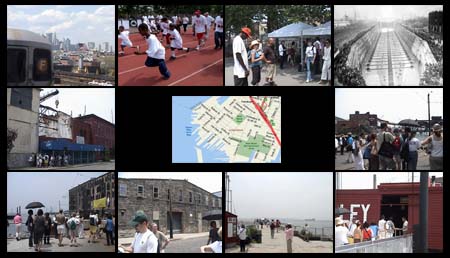
|
The Brooklyn Center for the Urban Environment sponsored a whirlwind walking tour led by Dan Wiley on Saturday. Stops included visits with grassroots organizers, a preservationist and a leading developer. (Track photo by Claudio Papapietro. Graving dock image courtesy of Brooklyn Historical Society. Map from Mapquest. All other photos by B61.)
Originally posted June 15, 2005
|
RED HOOK--A traveler wanders around the Erie Basin equipped with only a map. "It's a good place to stay away from, dat's all," explains a King's County native to the clueless outsider in Thomas Wolfe's short story "Only the dead know Brooklyn."
Much has changed since Wolfe's characterization was printed in The New Yorker in1935. Violent crime continues a downward trend, the wild dogs have been domesticated and real estate brokers clearly have no intention of staying away. Still, the rough terrain of Red Hook's politics can make even a longtime resident feel lost at times. On Saturday, 25 visitors took a walking tour of the fascinating place that Wolfe's unwitting traveler stumbled upon 70 years ago.
The tour was sponsored by Brooklyn Center for the Urban Environment and led by Dan Wiley, Community Outreach Director for U.S. Congresswoman Nydia Valazquez. It began at the unsightly Smith/9th Street. Two months ago the decrepit subway station was scheduled for $22 million in structural and aesthetic improvements. But the MTA has cut the rehab project altogether.
"When they hike the fare, they should improve the service," Assemblywoman Joan Millman of the neighboring 52nd district said recently. "I worry for the safety of my constituents." Councilman David Yassky has also spoken out against the cut.
The sight of the dilapidated station quickly evaporated on this mid-80 degree day. A taunting peek at the unfilled Recreation Center pool was followed by the smell of the South American food stands and visions of the vast green fields on Bay St. For all the neighborhood's limitations, Red Hook has phenomenal recreational areas.
At the track, Ray and Earl Hall greeted the travelers. Their organization, Red Hook Rise, teamed with the Red Hook Health Initiative for "Health and Fitness Day 2005." The event promoted exercise in the neighborhood and drew appearances from Borough President Marty Markowitz and Judge Alex Calabrese of the Community Justice Center.
Ray remarked to the tour group that "there was a time when people didn't come down here." The Hall brothers have dedicated their adult lives to leaving their old stomping grounds better than they found it. "I'm glad you came out to see the positive things that are going on in the neighborhood," Earl said privately. "And not just all the other nonsense." IKEA's promise of hundreds of job openings and training to local residents has secured the full weight of Red Hook Rise's organization behind the project. Visions differ on what is best for Red Hook's future. And the brothers' role in aiding IKEA's bid has angered many equally-passionate residents. Much of the disagreements have been public and personal.
If there is any common ground in the battle, the tour group unknowingly stepped on it as they crossed Columbia St.
Beside the towering walls of the former Todd Shipyards, fertile soil sits atop an old blacktop playground. In a neighborhood filled with surprises, few compare to the image of Added Value's organic farm where the tour met another grassroots leader, Ian Marvy. Farmer Ian, as he's affectionately known to neighborhood kids, has put his considerable energies and talent into providing job opportunities and healthy food in Red Hook. The unlikely plot yields organic produce that's sold to local restaurants Liberty Heights Tap Room and 360.
Community Education Coordinator Caroline Loomis and Senior Youth Leader Tevon McNair described the programs that employ up to 20 area teens every summer. In three years, Marvy and Added Value have received enough positive press to fill a book. What hasn't been written yet, however, is the impact that 11,000 cars will have on the farm as they stream into IKEA every Saturday. And the company's proposal did not include any mitigation for the significant noise and air pollution that will result from the traffic.
This fate will be shared by all users of the track and adjacent playing fields. However, IKEA hasn't reached out to Added Value as they have with other groups.
"There is potential for partnership," Marvy said of the farm's prospective relationship with a 350,000 sq. ft. neighbor. "But the immediate concern is for the appropriate [asbestos] remediation to be done at the site."
The root of Marvy's concern was the next stop on Wiley's tour. Building #3, a historic, civil-war era pump house at 11 Beard St., was partially demolished in January. Allegations of mishandling and misreporting of asbestos-contaminated material drew $183,000 in potential fines for IKEA's contractors. After two delays, U.S. Dredging Corporation and Breeze Demolition will answer the charges in front of the Environmental Control Board on July 8.
To address another growing community concern, Mary Habstritt of the Society for Industrial Archeology was on hand to administer a maritime history lesson at the site. The subject: a working graving dock slated to become IKEA's 1,400 car parking lot. Habstritt's presentation included copies of a Scientific American article that marveled at the Todd Shipyard graving dock when it was built in 1866.
The current site plan calls for the graving dock to be filled with demolition debris and covered with cement. But the Municipal Arts Society has developed two alternative site plans that they say would allow the store and the graving dock to co-exist. Wiley pointed out a plot of land at the end of Columbia St. that preservationists think would make a better parking lot than the graving dock. The plot currently is for sale.
IKEA representatives will address these concerns at a meeting with the Economic/Waterfront and Landmarks/Land Use committees. The presentation is scheduled for 6:30 p.m. on June 23 at the P.A.L. Miccio Center. As with all CB6 activities, it is open to the public.
Traversing over broken glass and uneven footing, the tour made its way down the gritty cobblestone corridor to the picturesque Beard St. Pier and warehouses. Brooklyn Waterfront Artists Coalition, Fairway's future abode and the sugar refinery provided Wiley with plenty of tour-guide fodder.
The Fairway building will feature an environmentally-friendly cogeneration plant that will utilize waste heat to generate power. A middle atrium will provide sunlight to the units on the inside of the building. And office space will be donated to non-profit organizations Red Hook Rise, BWAC and Dance Theatre Etc.
But even now the sights of the area speak volumes themselves. A walk through the office space unveiled the fantastic New York Harbor views as well as Blue Man Group props peeking through the hallway windows.
At this point in the tour, a visitor was heard to remark, "It's beautiful down here. But how would you get anywhere." New York Water Taxis are docked, ready to take commuters to Manhattan--just not from Red Hook. And trolley cars sit like immovable museum pieces. The trolley project was originally proposed and developed by Bob Diamond before a lack of funding and permits halted his progress. The idea may not be dead yet, however. According to Wiley, Congresswoman Valazquez has secured $300,000 in federal funding to conduct a feasibility study for a light rail system in Red Hook.
But for now the ferries and trolley cars are merely reminders that the neighborhood is so close, yet so far away.
An unplanned stop was made at Ralph Balzano's shop on Reed St. Neighborhood friends enjoying a casual Saturday afternoon seemed as awestruck by the sight of a walking tour as the travelers were by the sight of this one-of-a-kind waterside hangout. A brief exchange left both groups no less confused by one another before the tour moved on to the hospitable conclusion of the tour--the Waterfront Museum and Showboat Barge.
David Sharps' antique vessel and its homeport along the Pier 44 Jetty and Waterfront Garden are an example of Red Hook's future cohabitating harmoniously with its past. On board developer Greg O'Connell shed light on this project and those currently underway. He underscored the important role that artists have played throughout the development process, occasionally being interrupted by the sounds of the museum's complex ball contraption.
Walking tours in Brooklyn have traditionally ended at the Gowanus Canal. But that's where Wiley's began. And when Red Hook's retail industry booms and transportation improves, more and more outsiders will feel comfortable making the trek south of Hamilton Ave. Whatever issues arrive with the impending changes, one thing is certain: more maps will be unfurled on these narrow old streets. While they may show the visitors where to go, they won't begin to explain how it all got here.
|
State Supreme Court hears IKEA arguments
|
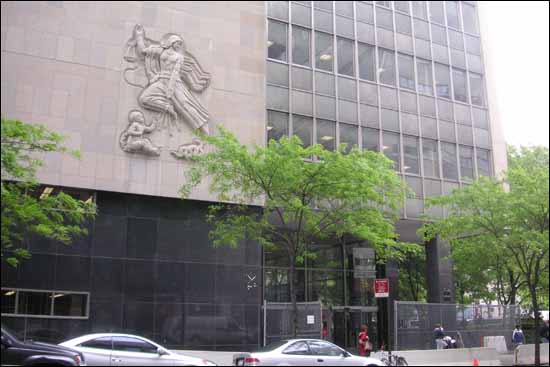
|
Pro- and anti-IKEA factions called Red Hook's "character" into question as they presented arguments in court Thursday. The parties argued over whether the City took the requisite "close look" at the plan's impact before they rezoned the proposed site. A full transcript of the proceedings is available at BigCitiesBigBoxes (B61 Photo).
Originally posted May 30, 2005
|
MANHATTAN--The battle over Beard Street's waterfront went before State Supreme Court Justice Karen Smith on Thursday. A lawsuit claims that IKEA's 1000-page final environmental impact statement (FEIS) did not properly examine the impact traffic will have on "neighborhood character" and the surrounding highways. The hearing got off to an unpromising start for the petitioners, who aim to nullify the city's approval for the 350,000 square-foot furniture store.
Smith's opening statement made it clear that a heavy burden rests on the plaintiffs. "I can't substitute my judgment for that of the agencies," Smith said to the plaintiff's lawyer Antonia Bryson. "Your experts and their experts disagreeing, that's not going to do it."
However, by the end of the hearing, it was unclear whether Smith was satisfied with the defendants' explanation of at least one issue--traffic on the Gowanus Expressway.
"They are misrepresenting what their own papers say about consideration of the Gowanus and the other highways," Bryson argued. "They did not look at 'Will traveling on the Gowanus be a lot worse than it was before the Ikea was in place?'"
Turning to the defendants, Judge Smith said, "I don't remember seeing anything about the Gowanus and the highway, just the local streets. I may have missed it, so please let me know."
Dan Greene, lawyer for the New York City Law Department Office of The Corporation Counsel, cited pages from the FEIS that deal with traffic on the Gowanus Expressway
IKEA's FEIS does not take into account the planned reconstruction project on the Gowanus, Greene said, because that project was too far into the future. The study did consider the increased traffic from pending projects Carnival Cruise Lines and Fairway.
According to Bryson, the City's approval violated two plans that the City developed as guidelines for Red Hook's waterfront--the City Planning Department's 1992 Waterfront Plan and the 1996 197-a plan. Both plans recommend the site remain zoned for maritime activity. Though neither document is legally binding, New York State's Environmental Quality Review Act (SEQRA) requires city agencies to consider environmental impacts equally with social and economic factors.
That's where the experts disagree.
"Neighborhood character, under SEQRA, is to look at a compilation of factors, not just one factor; and moreover, it is undoubtedly the most subjective area of review," Greene argued for the defense. Binder and Greene described Red Hook's waterfront as publicly inaccessible and "falling down."
To which Bryson responded, "Red Hook has some lovely public access that's in development and it's going to have more, and this is not the site for public access. So to tout that as the whole reason for the project is not appropriate."
Bryson explained Red Hook's unique residential-industrial mix. "It gives the community its flavor and although we need economic development...there's no room...for big-box commercial stores."
Judge Smith made her personal feelings known throughout the hearing. "If it was up to me, I would...keep all streets cobbled and take all the corporate headquarters and cut them down in size and have everything the way it is on Chelsea and Ninth Avenue, but that's not what the law requires," she said, also stating her dislike of the proposed Jet's Stadium. Both sides jumped on the comparison.
"This is not the Jets stadium," argued Karen Binder of IKEA's law firm Wachtel and Masyr. "Because Ikea is [an] extraordinary company." She added that the project received active support from the Red Hook Tenants Association throughout the process and near unanimous support from the City Council and Community Board 6. The judge pointed out the small percentage of Council and CB6 members who actually reside in Red Hook.
Bryson contrasted the well-funded opposition to the Jets Stadium to those fighting IKEA. "The people who are opposing it here are not supported or funded by any other organization. Ikea went in and did do a very professional job here and it cultivated sections of the community, brought them to community meetings and educated them as to their point of view. So we have the deeply-felt beliefs of members of the community who are here opposing this versus Ikea's professional work in terms of other segments of the community."
For the defense Ms. Binder said, "If you look at Chapter 12 in the EIS, which is entirely devoted to the ten policy statements of the Waterfront Revitalization Program, we go through each and every one, and although the law doesn't require that you comply with it...we comply with every single one."
IKEA's study, however, does not offer mitigation for the significant noise pollution that would affect soccer fields, baseball diamonds and Added Value's Red Hook Farm on Bay St.
"It's not a subjective judgment I'm asking you to make to overrule them," Bryant said. "Yes, if they had looked at the volumes of traffic, it would have been within their discretion to decide whether it was significant enough to...change the neighborhood character. I'm saying they didn't look at it at all."
Failure to take a "hard look" at any area, Bryson submitted, is sufficient to overturn the decision. Whether IKEA studied the potential increase of traffic is not in doubt. The FEIS says that IKEA will draw 6,000 cars per weekday and 11,000 per Saturday.
Judge Smith seemed to sympathize with the petitioners when she noted the impact of the upcoming changes. "This community is going from an underdeveloped, perhaps, community to, all of a sudden, getting all of this at once." She continued, "There is going to be a nightmare of traffic and...if you lived there, you would say...'This does not make me a happy person.'"
Personal feelings aside, Smith's judgment in this case will depend on whether she believes the FEIS sufficiently dealt with the impact that traffic will have on the Gowanus Expressway and Red Hook's "character."
|
Laundromat owner fights off armed robber
|

|
A day after battling an armed robber, a local business owner was back at work with a harrowing tale to tell Tuesday. His accused attacker is in jail (B61 Photo).
Originally posted May 25, 2005
|
RED HOOK--It's been said that a feather floating at Commerce St. is a chicken by the time it gets to Beard St. In a neighborhood this size, stories have a way of becoming bigger each time they're told. But there is no reason to exaggerate the events that transpired down Van Brunt St. Monday morning. And the owner of a local launderette was happy to be around to tell the story Tuesday.
Just before 9 a.m. on Monday, the owner said a woman entered his business to ask if it was open. After he told her it was, she left. Then 46-year-old Edward Rodriguez reportedly entered the Laundromat inquiring about detergent. The 26-year-old owner turned his back and reached for a bottle when his affable customer service was twice met with the butt end of a .25 caliber automatic Raven pistol. After the owner fell to the ground, he says Rodriguez attempted to tie him up.
"I told him, take whatever you want, just don't kill me," the owner said as he related the story to the many concerned friends and reporters who gathered to hear his startling first-person account.
"He had Saran wrap on his finger tips and he had ties in his hands. I thought, 'I can't defend myself if he ties me up.'" Staring down the barrel of a gun, the owner instinctively hit his attacker and a struggle for the gun ensued. The pistol ended up on the floor as a passerby noticed the fight from the street.
"He saved my life," the owner said. "He came in and asked, 'Are you alright?' I yelled, 'this guy's got a gun.,'" After the passerby aggressively came to the defense of his neighbor, the robber reportedly fled with stolen money and the gun--leaving a puddle of his own blood on the floor.
"We ran outside, and pointed him out to police," the owner said. Officers Melanie Smith and Raul Perez from the 76th Precinct were patrolling the area and pursued the perpetrator. Rodriguez was apprehended near Pioneer St. Officers from the Red Hook Community Justice Center were also involved in the pursuit. The arrest was made at 9:15 a.m.
"I wish it hadn't happened. But to be here to tell you this story makes me feel great," the owner said Tuesday. "Thank God I've got friends in this neighborhood."
|
Graving dock debate enters new waters
|

|
A campaign to save the Todd Shipyard graving dock on the proposed IKEA site has piqued new interest. Preservationists tout its significance to Red Hook's legacy and lament the prospect of losing a valuable working asset to the maritime industry. CB6 will discuss whether IKEA and the dock can co-exist (Photo courtesy of the Brooklyn Historical Society).
Originally posted May 19, 2005
|
RED HOOK--Responding to broad-based appeals led by the Municipal Art Society, CB6 will discuss the future of the working graving dock (also known as a drydock) that is slated to become a 1,400-car parking lot. The dock, located at Beard and Dwight Streets, has been used to repair large ships in the Erie Basin since it was built in 1866. The New York Preservation Society has listed it as one of its "Seven to Save."
In a written statement, IKEA Spokesman Joseph Roth says that the company developed the plan over two years with input from residents, community groups and city officials. "Unlike these numerous community groups, the Municipal Art Society [MAS] did not provide input during ULURP [Uniform Land Use Review Process]."
"That's not true," says Carter Craft, Director of Metropolitan Waterfront Alliance, a MAS initiative. "We've been advocating to save the graving dock for more than a year. I testified at city planning meetings, to the city council, to the borough president and to the community board." One such presentation--"Maritime Facilities Are Critical For Our Prosperity-and Our Survival"--was delivered to the Land Use Committee of the New York City Council on Oct. 5, 2004. The City Council approved IKEA's plan (49-1) on Oct. 13, 2004.
CB6 District Manager Craig Hammerman says, "It's true that nobody brought it up during the process to the extent that it was (raised) after" ULURP.
But Daniel Wiley, Community Coordinator for Congresswoman Nydia Valazquez, remembers presentations by Craft and others, "It appears to me that IKEA is as careful with the facts as they are with asbestos. For IKEA to say MAS never voiced their concerns reminds me of IKEA having an asbestos assessment done on the site for the EIS [Environmental Impact Study] but not fully reporting it to the Department of Buildings or the Department of Environmental Protection when it came to the demolition."
Wiley was referring to the partial demolition of Building #3 at 1 Beard St. in January, and the DEP complaints stemming from the handling and reporting of asbestos at the site. The connection between the two situations is more than figurative. Hidden from pedestrian view, the graving dock rests below sea level and has pumps that remove water to allow repair workers access to the bottom of large vessels. Building #3 formerly housed the steam pump that dewatered the graving dock. And the 710-foot dock sits directly behind the remains of Building #3--one of five buildings on the site that are eligible for the National Register of Historic Places.
David Sharps of the Waterfront Museum also disputes the contention that concern for the graving dock wasn't voiced during ULURP. He cites a presentation (dated June 25, 2004) he gave to Brooklyn Borough President Marty Markowitz, City Council and CB6. In it he voiced his opinion, "I am very dismayed that the IKEA proposal calls for filling in the graving dock located on the property to make a parking lot. This ship building and repair facility is an historic maritime treasure. It is still both functional and operational. To render it completely useless for a parking lot is an irreversible act."
To accommodate its parking lot, IKEA plans to pave over 80% of the dock, and leave the remaining portion filled with water as a large museum piece. The plan "to expand the public waterfront esplanade and to retain the property's historic gantry cranes and a portion of the drydock were all the result of public suggestions and input," according to Roth's statement.
IKEA has an agreement with Erie Basin Marine Associates to relocate Tri-State Ship Repair from Perth Amboy, New Jersey to Red Hook. The company says it will operate one or two floating drydocks to repair tug boats, barges and ferries in the area.
In February, IKEA Real Estate Director Patrick Smith released this statement, "We recognized from day one what the Red Hook waterfront has historically meant to Brooklyn's and the City's economy, and we are delighted that we have been able to maintain a significant 'working waterfront' as part of our IKEA Red Hook project."
But opponents are not delighted. They cite not only the graving dock's historical significance to Red Hook's maritime legacy, but also its present function of accommodating vessels too large for Tri-State's floating drydocks.
A senior corporate officer at Stevens Technical Services, which currently operates the drydock, says the company repairs an average of ten ships a year and employs up to 200 people (100 employees, 100 subcontractors) at a time. "It's a very specific workforce. They're trained in this complicated field and are highly skilled and knowledgeable. [IKEA] wants to throw all that out the window." He adds "There's plenty of demand. It's one ship after another." IKEA says that its agreement with Erie Basin Marine Associates will employ "dozens."
Wiley says that Congresswoman Valazquez has expressed "a number of concerns to IKEA in a formal letter sent last August that included concern over local jobs and saving the graving dock, to which we had no reply from IKEA."
Craft clarifies that MAS has not taken a position against IKEA building a store at the proposed location. But he believes that it's important to "save the unique and valuable asset. Unfortunately it has been presented as an 'either or.' But in reality it's not."
MAS developed two alternative site plans, designed by Preservation Committee member Harold Fredenburgh, AIA, an architect with experience in accommodating parking structures in difficult sites. Both plans have garnered support from Congresswoman Velazquez, State Senator Velmanette Montgomery and City Councilman David Yassky. The plans have been delivered to IKEA, but MAS has not received a response. A lawyer representing IKEA called MAS's plans "not viable" following a presentation at the PAL Miccio center on Wednesday night.
Roth's statement concludes, "We look forward to developing the IKEA Brooklyn project...that was approved last fall by the City of New York."
The debate over the parking lot aspect of the plan continues, however, as CB6's Economic/Waterfront Development and Land Use committees will take up the issue in a joint session. Both sides are sure to be heard.
|

|
CB6: Full inspection needed at Ikea site
|
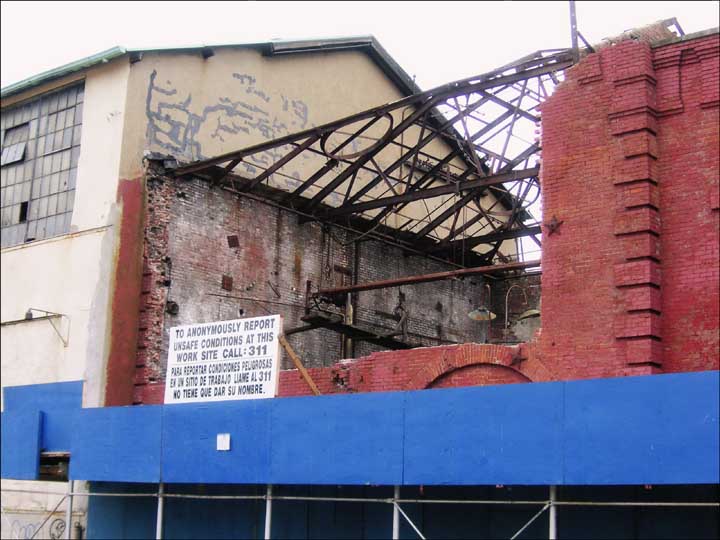
|
The razing of Building #3 on Beard St. was messy, even by demolition standards. The fallout continues as details emerge of alleged malfeasance by an inspector hired by contractors. (B61 Photo)
Originally posted May 16, 2005
|
RED HOOK--Allegations that asbestos levels at a demolished building on the proposed Ikea site were inaccurately reported have prompted Community Board 6 to request a full inspection. The appeal will be made to both the Department of Environmental Protection and the Department of Environmental Conservation.
Board member and Red Hook resident Lou Sones has been arguing for this motion for months, and saw it pass without objection at last Wednesday night's general board meeting at Borough Hall. Reduced to rubble more than five months ago, Building #3, a two-story, civil war-era building demolished in January at 1 Beard St., was one of the smallest buildings on the site, but continues to be a major point of contention between pro- and anti-Ikea factions.
Sones surmised of the Board's eventual approval of his motion, "Valid arguments on my behalf and people understanding my point of view. But more importantly, is the malfeasance and the reporting of the malfeasance that's taking place at the site and the inability of the agencies up until now to accurately monitor what's happening. So now I think people realize that more oversight has to take place."
Since Ikea is not the current landowner or named in any complaint, the company says that it would be inappropriate for them to comment on the violations levied against United States Dredging Corporation, Breeze Demolition and DEP-certified inspector Thomas Parisi. Parisi was hired by the contractors to file a report with DEP detailing the amount of asbestos contained at Building #3. He has now become the focal point in the argument for a thorough inspection of the entire site. DEP spokesperson Ian Michaels said that the 1 Beard St. complaint is one of at least five that are pending against Parisi. At this time he has not been convicted on any charges.
In 2002, Ikea conducted and published an asbestos report which found that "The buildings and structures...contain a considerable amount of asbestos containing materials." Specifically the roof of Building #3 was an asbestos contaminated material (ACM), and that a significant amount of ACM debris was found inside. Parisi only reported ACM in the window caulking of the building.
District Manager Craig Hammerman voiced his support for a full inspection taking place. "We were outraged to find out that there was some malfeasance with regard to the inspector that we all relied on to protect the public from exposure to harmful materials. The agencies, at this point, need to do a lot to help restore our confidence in their ability to protect us."
However, according to Michaels, the community board shouldn't expect a full inspection of the site by the DEP. "The system is the system. We don't do that. We don't have the resources to do that." That responsibility lies with independent inspectors who are certified by--but not employed by--the DEP. However, he said that they have asked the city's Department of Buildings (the agency that administers demolition permits) to immediately alert the DEP when any permit is requested for this site. He added that all future requests would be "subject to the utmost scrutiny" by his agency.
DEC spokesperson Maureen Wren said her agency will review the board's concerns. She said DEC's direct oversight at the location typically follows the remediation process, before demolition begins. DEC's jurisdiction in this case stems from the site's status as a brownfield project.
Regardless of whether the city agencies agree to further inspection, there are no plans for demolishing the other buildings on the 22-acre site before Ikea closes on the property (originally set for early spring). In a written statement released in February, Ikea said that they "have planned all along to initiate a comprehensive asbestos remediation plan for the site." The permit to demolish Building #3 was granted based on an emergency request by the contractors who said the building was in danger of falling down.
Once the sale is finalized, Ikea says it will begin three to four months of asbestos remediation before proceeding with demolition. Due to the controversy swirling around Building #3, a host of interested parties, including citizen groups, DEP, DEC and the Army Corp of Engineers will be watching the process closely.
Breeze and U.S. Dredging were initially scheduled to go before the environmental control board on May 6, but the hearing was postponed until June 7 to allow Breeze's new legal team time to prepare. U.S. Dredging's lawyer Philip Karmel has since stated that they will argue the ACM in question was not friable (easily crumbled), and therefore not subject to the regulations that the DEP claims they violated.
"[Lillith Ziegler Ferrel] said it herself," Karmel said, referring to DEP Director of Community Outreach's presentation to the Public Safety/Environmental Protection committee on April 25. "She used those words, 'not friable.'"
Familiar with the argument, Michaels at the DEP responded flatly, "Whatever. They can make any argument they want. They can make it to the judge. They will have their day in court."
|
Rain christens Pier 44 Jetty and Waterfront Garden
|
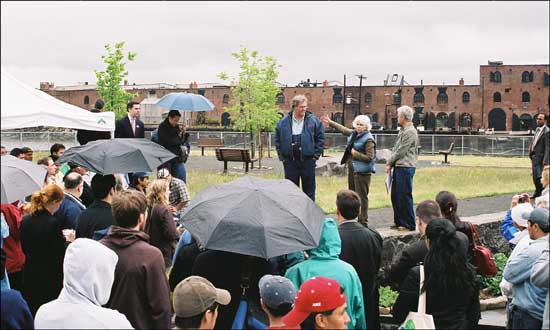
|
Accomplished public garden designer Lynden Miller unveils her newest work at the foot of Conover St. The project was built and financed by Greg O'Connell (Miller's right). Debbie Romano (Miller's left) of Pier 41 Associates emceed the event that hosted several prominent politicians (B61 Photo). Originally posted May 23, 2005.
|
RED HOOK--There were no oversized scissors. There wasn't even a ribbon. All pretense was set aside Friday afternoon for the unveiling of the Pier 44 Jetty and Waterfront Garden. The masses huddled in the shadow of Lady Liberty. And the rain dampened the newly-planted bunchgrass along with the aspirations of photographers who sought a picturesque documentation of Red Hook history. It was somehow fitting.
As puddles rippled under a light drizzle, financier and developer Greg O'Connell stood at the entrance and welcomed well-wishers, politicos and the construction workers who built the new public park. The park, designed by the renowned Lynden Miller, sits at the end of Conover St., presenting a panoramic view of the New York Harbor. Miller adds the park to her resume which also includes Central Park Zoo, Bryant Park, the New York Botanical Garden and Wagner Park in Battery Park City.
Addressing the crowd were Miller, O'Connell, Borough President Marty Markowitz, District 12 Congresswoman Nydia Valazquez, Gifford Miller (Mayoral hopeful and son of the designer) and City Planning Chair Amanda Burden.
Gifford Miller cited his mother's distinction for having designed parks in all five boroughs, while Burden and Markowitz talked about Red Hook's status as "the hot spot." Markowitz credited O'Connell for putting "dollar signs" in every developer's eyes when they now look at Red Hook.
Due to inclement weather, David Sharps welcomed the crowd aboard his Waterfront Barge and Showboat Museum, which now calls Pier 44 its homeport. The barge returned to the harbor recently after undergoing work to repair damage caused by wood-eating shipworms. Every Sunday in June, the barge will host CIRCUSundays featuring Billy Bones the Good Pirate, hip-hop baton twirler Anthony Bryant, trapeze artist Lumia and magician Torkova.
The Pier 44 Jetty and Waterfront Garden is one section of the half-mile public walkway that will extend along the shoreline from Pier 41 near Van Dyke St. to the Beard St. Warehouse. Set between the civil-war era buildings, the park stands as a metaphor for Red Hook as a whole. Soon flowers will bloom from ground once thought inhospitable. It will be open to the public from dawn until dusk seven days a week...rain or shine.
|
Two art galleries and a microphone
|

|
"Multi-media" was the theme of Friday the 13th in Red Hook. Two art galleries on Van Brunt St. held previews of work to be raffled off later this week, and The Pharcyde headlined at The Hook. And oh yeah, BWAC barreled on.
|
RED HOOK--As a neighborhood, Red Hook is bracing itself for seismic shifts. Some new businesses are hoping to just stay afloat until talk turns into actual dollars. Film crews are on constant scouting missions. And every bright idea gives birth to a million heated arguments. Lifelong residents will tell you, Red Hook has been "just about to explode" for the last decade. On Friday night I took a break from asbestos, crime and dry docks to catch a glimpse, not of our "can't-miss" prosperous future, but of our unique and shared present.
No one adapts to change like artists. And The Kentler International Drawing Space is living proof. Founded in 1990 by artists Florence Neal and Scott Pfaffman, the gallery helped pave the way for today's burgeoning creative community. On Friday the gallery held a "Meet the Artists" reception as part of the third annual 100 Works On Paper Benefit. On Thursday, May 19, the gallery will raffle off the 100 works to 100 ticket holders.
Up the street at the Diesel Gallery, Stuart Nicholson held a preview to the "Continuum II" benefit. Southside Speedway and Betty Ford All-Stars provided a mix of country, rock and punk in the backyard. Meanwhile, art enthusiasts and hack internet journalists viewed the selections of art to be raffled off next Saturday, May 21st, 7-10:30 p.m. The Jazz Rats, a collaborative jazz project from DUMBO, will perform throughout that catered event.
As the Betty Ford All-Stars headed over to play a second set at Lillie's, Jeffrey Goldin's night at The Hook was just beginning. It's the general manager's job to worry the night of a show. And delivering a major act to Commerce St. brings with it a high degree of stress. In the end, a couple hundred hip hop fans piled in front of one of the best stages in Brooklyn, if not the entire city.
In this storied neighborhood the phrase "Old School" conjures up images as varied as Al Capone and Sugar Hill. But to the young and attractive crowd that found their way to The Hook on Friday, The Pharcyde's brand of West Coast hip hop defined "Old School." Patrons of the club will be seeing a lot of the opening band, The Chronic Electric Orchestra, according to Goldin, "They were that good."
Next week The Hook welcomes Psychic TV. The club will offer a free shuttle bus from Smith and 2nd Streets.
|
BWAC and Red Hook share big weekend
|

|
Nora Jackson, Matt Nudelman and their daughters Miranda and Juliet were four of the 1300 people to take in the BWAC Pier Show on Saturday. (B61 Photo)
Originally posted May 9, 2005
|
RED HOOK--"It was an excellent opening," John Strohbeen, President of the Brooklyn Waterfront Artists Coalition, summed up the first day of his organization's 25th Anniversary Spring Art Show. "We set a record number of art sales with over 50 pieces sold, around 1300 people came in," Strohbeen discussed Saturday just as Sunday began. "And everyone seemed to be having a pretty good time."
Of course, it is Strohbeen's job to put the best face on an event touting itself as the "salvation of the ever burgeoning fine art center that is Brooklyn." But with 360 artists displaying 1500 works inside the historic civil-war era Beard St. warehouse, talking-up the event must be the easy part of his job. As it now seems likely to improve upon the attendance record it set last year, BWAC has also seen recent growth in the neighborhood that it adopted 13 years ago (after developer Greg O'Connell donated use of the 25,000 sq. ft. facility).
Amid Sunday's brunch crowd, Gary Rego co-owner of the Hope & Anchor diner explained the impact BWAC has had on his business, "We plan for it. This is a huge weekend for us. It's really been wonderful. It's grown so much. And we've grown with it." The diner has been open for four BWAC spring shows.
"When we first opened, there was nobody here," Rego remembers. Today a furniture store, bakery, wine boutique, pet store, French restaurant, woman's clothing store and two new bars line the stretch of Van Brunt St. leading to the piers. While development in the neighborhood has moved too slowly for some, and too briskly for others, BWAC's growth shows no sign of slowing down.
CORRECTION: David McKenzie points out that BWAC was not "lured away from Williamsburg" 13 years ago, as previously stated. McKenzie and Anne Rosenthal approached O'Connell when their situation became untenable at 68 Jay St. in DUMBO. Thanks to David for the correction, and we apologize for the error.
|

|
Miles Mukamal enjoys a performance by Banjorama! outside LeNell's on Van Brunt St. on Saturday. Meanwhile at Lillie's, Steve Tarpin, of Steve's Authentic Key Lime Pies, provides the entertainment for a birthday party for Bruno and Gaius, two of the many offspring of Steve's dog, Mango--thought to be the most prolific Jack Russell Terrier in Red Hook. (B61 Photos)
|
Holding down the fort, Lillie's doors swing wide
|

|
|
|
Armed with a renewed liquor license and optimism, Lillie Haws reopened the doors to her urban saloon two weeks ago. Photo from danconnortown.
By Steve McFarland
RED HOOK--On the otherwise desolate eastern edge of Beard St., Lillie's two-month closure had many country music fans worried that this welcoming Brooklyn venue may be gone for good. With Red Hook's rapidly growing landscape of bars, who would miss it? Tag along with Lillie these days and you quickly find out.
"It is so good to see you back," local activist John McGettrick said as the two bumped into one another at Hope & Anchor last Friday afternoon. As he often does, McGettrick was simply voicing a deeply-felt collective opinion of many in the neighborhood.
It is a familiar refrain as Lillie makes her way up Van Brunt St.--the budding main drag of a small neighborhood that Lillie has helped make even smaller with her warm hostess persona.
"It's like Mayberry," says the Tennessee native. "Everyone knows one another and knows everyone else's business." Those who know her best, know how difficult the last two months have been for Timeout's Bartender of the Year, 2001.
Sitting in the outdoor cubby space halfway to the back of his bar, Sunny Balzano waxed poignantly on one of his closest friends. "Lillie is a soldier. She gets out there and does what she has to do. Not because she wants to run a bar. But because she has to, you see? It's her art."
Practicing her art at 46 Beard St. since March 2001, Lillie is still relatively new to a neighborhood that maintains strong ties to its long, storied, dangerous and colorful past. With that said, Lillie readily shares her extensive knowledge and appreciation for the history of her establishment that was operated by the Savarese family from 1900-1953.
"They came back once. They're in their 80s. We sat in the garden and they drank me out of white wine," she said passing photos of the family across the bar. "She died of a broken heart after the first World War," pointing to a woman in the photo.
Throughout its history, the building has served longshoremen, gangsters and artists. But it has never struck much of a chord with hipsters looking for the next "big thing." Lillie quips that the only trucker hats she sees are worn by actual truckers.
Certainly, the boom of attracting such a crowd would temporarily benefit the bottom line of a business that sees no foot traffic on a stretch of street that is still paved in brick. But the lack of a fickle, transient clientele ensures the survival of the down-home vibe that Alex Battles of Whiskey Rebellion remembers fondly from the first time he played Lillie's. The show in May 2001 also happened to be the first show Lillie's ever hosted.
"It's the day of the first show. And your first gig is the most exciting thing possible. Nervous as hell. We rehearsed six hours before the show and then got a call from a guy that worked there at the time," Battles remembered. "And he asks, 'So do you guys have any mike stands?' I didn't have anything but my guitar and my hat. And I had 20 friends driving down to Lillie's."
After a frantic but fruitful equipment search the band played where a stage would be built a year later, and struggled to be heard over the noise of a loud fan above the exit. Today a P.A. system is in place and rich, red velvet curtains swathe the stage. But the friendly vibe remains.
"It's such an open-minded bar. The regulars are willing to say 'hey, we'll give this guy a shot.' I've played a lot of bad shows," Battles readily concedes. "But I have never played a bad show at Lillie's."
So the Brooklyn country music scene has a beloved venue back. But as with almost every story concerning Red Hook these days, IKEA looms large on the horizon. No business will be impacted by the excavation and construction more than Lillie's (except for possibly Red Hook Farm run by Added Value, but that's a story for another time).
"I'm not against development. I just don't know what direction it will go. Are we going to be serving apple martinis to desperate housewives all of a sudden?" she wondered out loud. "I don't see them coming here for a Harvey Wallbanger, then going across the street for a wall unit."
With her come-what-may attitude, Lillie is prepared to soldier on. And judging from the schedule of her upcoming events, she's not alone. "It's so uplifting," she says of the outpouring of support. "It gives me a lot of strength."
Back in Sunny's cubby space, he put Lillie's bar in perspective.
"If you look at Red Hook," he said holding his hands as if they were hovering over a miniature neighborhood set between he and I. "Lillie's is a fortress that protects that corner of Red Hook. You see? Just like this bar is a fortress on this end. If she were to be gone, there would be vulnerability on that corner of the neighborhood. You can imagine that picture," pausing for a moment to allow the image to sink in. "Alright? We need her. It's like that."
|
Brooklyn authors make debuts at Sunny's
|
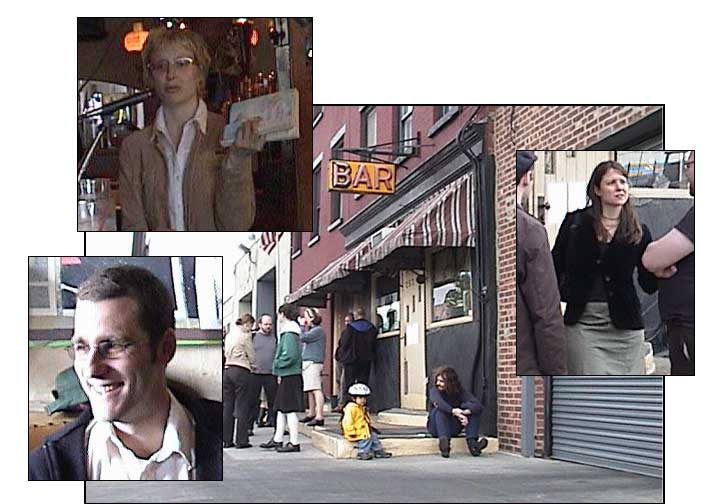
|
Alison Smith (top left), Jen Banbury (top right) and Christian Hawkey (bottom left) were featured at this month's book reading at Sunny's. (B61 Photos)
|
RED HOOK--Three distinct styles were on display at the distinguished Sunny's Reading Series on Sunday. Coordinated by Gabriel Cohen and co-sponsored by Book Court bookstore, the latest installment featured memoirist Alison Smith, war correspondent Jen Banbury and landscape poet Christian Hawkey.
Smith read a chapter from her book, Name All the Animals (one of People's ten best books of the year). The selected chapter told of a high school scandal from the author's adolescence, which she spent under the watchful eye of the nuns at Our Lady of Mercy School for Girls. Smith prefaced her reading, "As with many high school scandals, it started with a girl."
Banbury, journalist for Salon, read one of her dispatches from "Boots on the Ground: Stories of American Soldiers from Iraq and Afghanistan." Banbury recounted raids on Iraqi homes--often the wrong homes. Her personal narrative expressed sympathy for the confused and angry families without passing judgment on the individual soldiers.
Hawkey, an assistant professor of creative writing at the Pratt Institute, provided a poetic ending to the day on the waterfront for the 40 people in attendance. The author of The Book of Funnels, treated the appreciative crowd to several selections as he unfurled vivid organic imagery and mixed it with a rye, self-aware sense of humor.
With their appearances Sunday, Smith, Banbury and Hawkey added their names to a growing list of notable New York authors that have shared their work in Sunny Balzano's historic bar.
|
|
Also this week, the Brooklyn Stage Company has transformed Sunny's backroom into a professional performance space for their run of "Subterranean Homespun Pinter." The absurdist play by Harold Pinter--featuring Tracy Balzano, Lilith Beitchman and Robert Malloch--opened with three performances last weekend and continues with shows this Thursday, Friday and Saturday night. All shows begin at 8 p.m. and are free. Stay tuned for future performances at this exciting, newly-renovated space.
|
Burglaries rampant at construction sites
|

|
As new buildings have gone up, so has the rate of burglaries this spring. The trend has concerned residents and attracted the attention of police who are assigning more patrols to the area. (B61 Photo)
UPDATE: 10:58 a.m. May 10, 2005--Police have arrested Jason Gonzalez, 19, in connection with two burglaries on Van Dyke St. between Dwight and Richards Streets. Police say that between 2 p.m., April 28 and 11:30 p.m., April 29, Gonzalez entered a commercial property through a possibly-unlocked cellar door and removed a $100 Sawzall tool. Directly next door, according to police, Gonzalez climbed a fire escape and entered a residential building through a bedroom window at 1 p.m. on April 29. The 23-year-old female resident confronted him and Gonzalez fled with a $300 necklace.
Deputy Edwin Cesario of the 76th Precinct recovered the jewelry after it had been sold. Cesario then tracked down the accused burglar and made the arrest on May 3 when the owner of the necklace identified Gonzalez in a lineup. Gonzalez faces two counts of third degree burglary.
Originally posted May 9, 2005
|
RED HOOK--Developers aren't the only ones benefiting from the booming real estate market these days. Opportunistic criminals have struck at many construction sites in the area, and that has police at the 76th precinct dedicating more of their attention to Red Hook. A full-time beat officer has been reassigned to Van Brunt St. with the hope of curbing the current rise in theft.
Public Affairs Officer Paul Grudzinski at the 76th explains the strategy of the community policing effort which involves patrolling on foot, bikes and scooters in addition to cars.
"They're closer to the community. They stay in the same area so they get familiar with the store owners and the residents. They get a taste of what it's like to live in the neighborhood, because they know the flavor of the particular areas."
Grudzinski, a former beat cop himself, believes this familiarity builds trust between the police and those they are charged to serve and protect. The assigned officer is likely to also become familiar with a rising level of frustration among those affected by this latest wave of crime.
Among them is Victor Alicea, who just last Sunday was the victim of a burglary on Dikeman St. The 17-year Red Hook resident believes the criminals that are targeting the construction sites think they are stealing from the "new wealthy" in the neighborhood.
"It seems to be a calculated theft. (Thieves) have a misconception that with the large influx of people coming in and with rents getting higher, that the people they're stealing from are rich," he said. But actually, they're stealing from construction workers who are simply plying their trade. Alicea lost $3000 in heavy-duty tools and equipment from a job site where he was doing steel framing. A strong box in his basement was drilled and the contents emptied.
Fellow resident Stefan Zarember echoes Alicea's sentiment, "They're stealing from people who work with their hands. They're stealing their livelihood." Zarember recently recovered his own stolen bicycle when he chased down a person he saw riding it down the street.
In addition to the construction site thefts, police have also responded to muggings in the area. May 1 a 44-year-old man was punched in the face three times by an assailant who stole his $80 cell phone and $25 in cash. The victim described the mugger as a 5'10" black male wearing a gray sport jacket and white sneakers. The incident took place on the 770 block of Hicks St. at 5:15 a.m. At 5 a.m. the next day on the northeast corner of Hamilton and Henry St., a 75-year-old woman was robbed by a man who brandished a knife and threatened to kill her if she called police. The perpetrator, described as a 5'6" Hispanic male with gray hair, stole a $150 gold chain and a $150 cross. She said he fled into the Red Hook Houses area. Police responded but their canvas of the neighborhood yielded no results.
The growing unease in the community is mirrored by statistics from the 76th precinct. There have been 20 burglaries in the last 28 days for which numbers are available (ending April 24). That is up from eight during the same period in 2004 (a 150 percent increase in burglaries, 17.8 percent increase in total reported crime). Despite this up-tick, the area served by the 76th precinct has experienced the lowest total reported crimes this year to-date (225) among Brooklyn precincts. Not coincidentally, perhaps, the population--43,671 according to 2000 census data--is also the smallest of all Brooklyn precincts.
Police are asking residents to be aware and call 911 or the precinct directly at (718) 834-3211, if they see anyone acting suspiciously. The more detailed the descriptions, the more beneficial they will be to responding officers. And anonymous tips, while appreciated, are less helpful because they don't allow police to follow-up with witnesses.
|
Portside New York lays out blueprint for change
|

|
Carolina Salguero unveils Portside's plan to "breathe life into the relationship between Red Hook's landside community and the maritime sector--to the advantage of both." (B61 Photo)
Posted May 3, 2005
|
RED HOOK--"Imaginitive." "Well thought out." "Refreshing." These phrases are certainly not offered lightly when it comes to new proposals concerning Red Hook's waterfront. But Portside New York's presentation at the P.A.L. Miccio Center Monday night, received universal approval from the Economic/Waterfront Development Committee of Community Board 6--a committee often faced with the most contentious issues affecting the neighborhood.
But this wasn't IKEA or Carnival. This was South Brooklyn-native, Carolina Salguero laying out a forward-looking plan for a small community about to experience transition on a grand scale. Committee co-chair Al Nembhard's opening statements set the tone for the evening as he introduced Portside as, "A new entry into the ranks of folks who are going to do battle for the good guys on the waterfront here."
Salguero, who spent two and a half years on New York City tugboats as a documentary photographer and writer for National Geographic, lamented the fact that many "revitalization" efforts consist of simply putting benches close to the water and offering very little engagement with the water itself. She presented her comprehensive proposal in stark contrast.
At the heart of the plan is Portside's philosophy that the water can be used as a tool for community development by utilizing it for transportation, recreation, education and cultural inspiration. A maritime career center, museum and on-the-water activities will all be designed to match industry and community needs with programs and services. In addition, Portside will offer retail space that will simultaneously provide revenue and satisfy a glaring demand for residents.
"I know there are some things about Red Hook, as much as I love it, it's not the easiest place to live," said Salguero, a Red Hook resident. "There are some really basic amenities and services that people can get in lots of other neighborhoods that we don't have."
Portside also intends to help facilitate a relationship between tug crews and the newest entrants to the waterfront, Fairway, by building tie-up infrastructure near the 52,000-square-foot grocery store.
"The maritime industry is essential and needs to be maintained in this city and also really protected because the current revitalization hasn't found a way to include it in the mix," said Salguero "But its relationship to the landside community can and should change."
When it comes to Red Hook, change seems to be the only constant. For one night at least, a representative community group caught a glimpse of a vision for the waterfront's future that they could agree on.
For more information see Portside's website.
|
DEP meets with CB6, skepticism regarding asbestos
|

|
Board member Lou Sones authored a motion Monday night requesting that DEP and DEC inspect the entire proposed IKEA site for asbestos. Daniel Wiley, Community Coordinator for Congresswoman Nydia Velazquez, shows DEP representative Lilli Zeigler Farrell a picture illustrating the proximity of structures to the building where contamination was found. (B61 Photos)
|
Posted April 26, 2005 CARROLL GARDENS--The demolition of a Civil War-era building at 1 Beard St. kicked up much more than dust in January. And while the bits of red clay may have settled long ago, the argument over the asbestos-related violations at IKEA's proposed parking lot has not. The Department of Environmental Protection rehashed the violations at Community Board 6's Public Safety/Environmental Protection committee meeting Monday night. Anyone who hoped the presentation would end the debate about the violations, left St. Mary's Residence (41 1st Street) dissatisfied.
"I find it very disappointing," committee member and Red Hook resident Lou Sones said following DEP Director of Community Outreach Lilli Zeigler Farrell's presentation. "The problem with this is that you guys come after the horse has been let out of the barn."
"We can't be everywhere," Farrell responded. "We went. We inspected. They've gotten a number of violations. And they're going before the environmental control board."
Sones voiced his opinion that the entire site should be inspected before further demolition is allowed because, "there is already a track record of them doing illegal asbestos removal (and) denying access of your inspectors." Later he added, "DEP inspecting it after a complaint is not solving the problem."
A motion passed at the conclusion of the meeting to write a letter requesting a proactive inspection of all the buildings on the 22-acre site by DEP and the Department of Environmental Conservation. The site comes under DEC jurisdiction because it is a brownfield site.
United States Dredging Corporation, the current land owner, received $100,000 in potential fines. Breeze Demolition, a Red Hook-based company, could pay up to $80,000. While no one from these companies or IKEA spoke at the meeting, Philip Karmel of Bryan Cave LLP, a law firm representing U.S. Dredging, was on hand and answered questions afterward.
He stated U.S. Dredging's intention to contest the violations based on the position that the asbestos was not friable or airborne. The hearing is scheduled for May 6 at 9:30 a.m. Among the violations were the contractor's failure to provide a worker decontamination system, to provide a waste decontamination system, and to bag asbestos-contaminated material directly upon detachment from the substrate.
In her presentation, Farrell said that there was little potential for harm to the surrounding community because the demolition area was in the middle of the site and the asbestos-contaminated material was in solid pieces. "The people who were probably in danger would have been the workers."
|

|
Brooklyn Waterfront Greenway comes into focus
|

|
The Brooklyn Greenway Initiative envisions a much different Columbia Street. The small photo was taken before reconstruction began. The street's future looks something like the large photo-illustration.
|
Posted April 22, 2005 RED HOOK--The post-industrial perimeter of Red Hook is beginning to show shades of green. Milton Puryear of the Brooklyn Greenway Initiative presented his organization's fourth and final draft to Community Board 6 at Thursday night's transportation committee meeting. The committee, convened at Independence Bank on Lorraine St., voted to recommend approval for implementing the plan for the 14 mile multi-use trail.
With 90 percent of the route defined, the path will run along Brooklyn's western shoreline from Greenpoint to Bay Ridge. Securing the right-of-way for a project of this magnitude has required cooperation of many private interests and an alphabet soup of public jurisdictions (Department of Transportation, Economic Development Corporation, Port Authority, Parks and Recreation among others).
Puryear noted specific cooperation from Port Authority which agreed to move several fences in order to allow for a wider path along Columbia St.
Dalila Hall of the DOT also addressed the committee. She expressed support for the project and voiced DOT's intention to help implement the plan in conjunction with new capital projects along the waterfront, such as the $16 million reconstruction effort underway on Columbia St.
On Friday, BGI Chairman Brian McCormick explained how the project has gathered steam as it now enters the engineering and design phase.
"We've walked every inch of the waterfront. Literally going block to block," McCormick said of BGI's effort to resolve issues among all the affected parties.
McCormick cites the cruise ship terminal along pier 11 and the Brooklyn Navy Yard as areas where the plan has gained particular "traction." He predicts Red Hook will begin to see fruition of the proposal within two years.
Earlier this month the plan received a financial boost when Congresswoman Nydia M. Velazquez (D) announced that $25.5 million in federal funding had been secured for transportation projects throughout the 12th congressional district. Of that total, $8.25 million will be allocated to the Greenway project over the next six years.
"Securing funding for these projects will enable us to improve public access to our waterfronts, enhance our streets and bike paths with green landscaping for pollution mitigation, and make pedestrian crosswalks safer and easier," Velazquez said in a press release.
Despite all the positive developments, the BGI is taking nothing for granted. Public hearings will continue to be held during each future phase, as they have been throughout the process.
"There's been a lot of momentum this year. It takes getting everyone around one table," said McCormick, who has been an advocate for the Greenway since 1998. He added, "It's not inevitable until you make it inevitable."
For more information, visit BGI's website.
|
| |

